Special thanks for making this special possible to:

This special takes you on a journey in which you can explore the lives and behaviour of European owls, from hunting to food processing and from migration to conservation. The basis is formed by comparisons of external and internal morphology, linked to physiology and behaviour, which is used to explain ecological differences between owl species. It goes beyond the commonly known owl adaptations, based on novel data analyses derived from newly performed dissections. What is commonly considered as an ‘owl characteristic’, is often not applicable to all owls, but dependent on the current state of a species’ evolution, arisen from the interplay between evolutionary relationships and ecology.
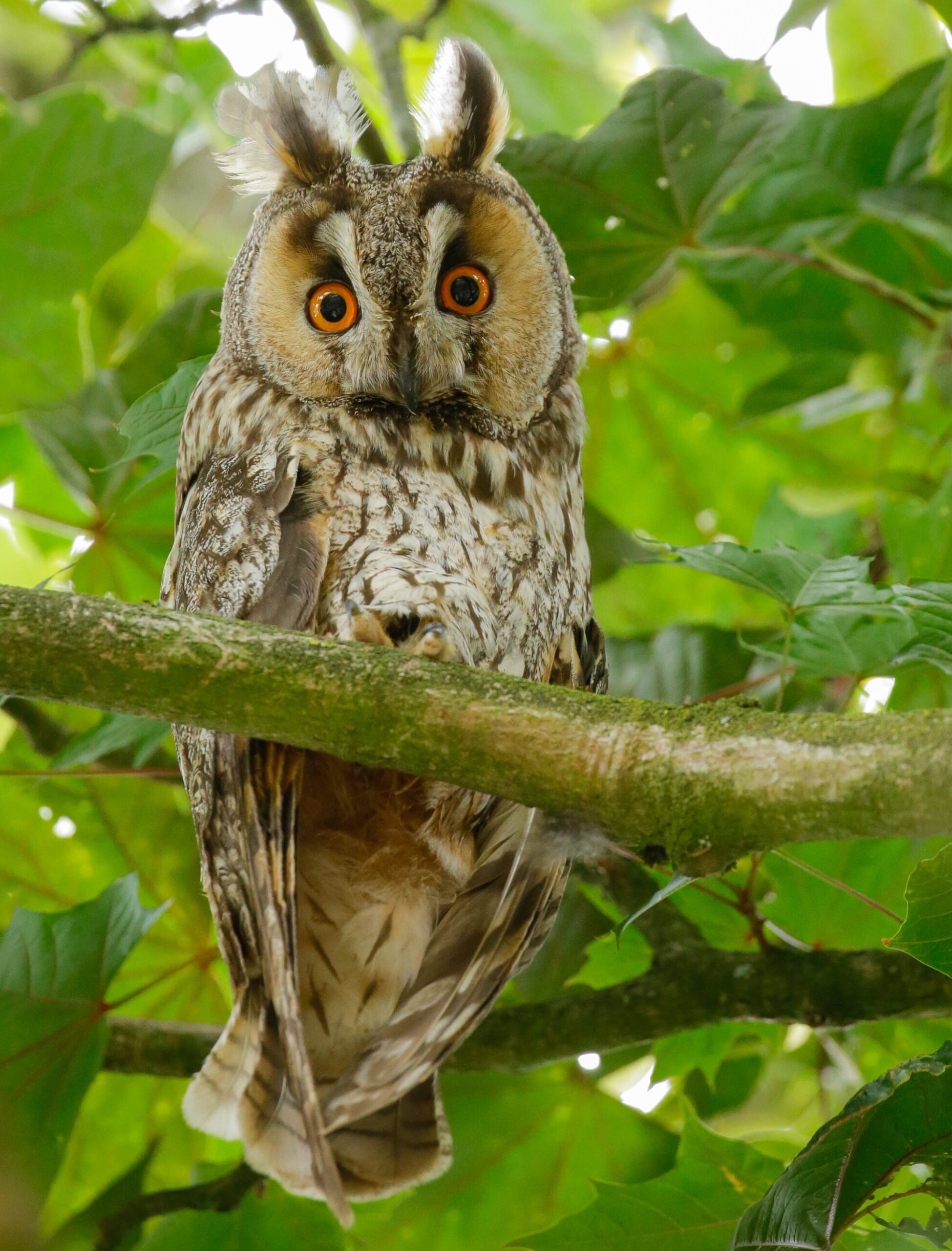
Owls share traits, but occur in various habitats and may look and behave differently, which can have different drivers. This results in variation among morphology between owls, which is connected to their evolutionary background and lifestyles. In avian phylogeny (BOX I), owls are positioned relatively close to diurnal birds of prey. The latter share ecological aspects with owls, but also have quite different behaviours and anatomies; hunting in daylight, for instance, and the (lack of) physical adaptations in relation to it. Therefore, we include them in comparisons with owls now and then in this special.
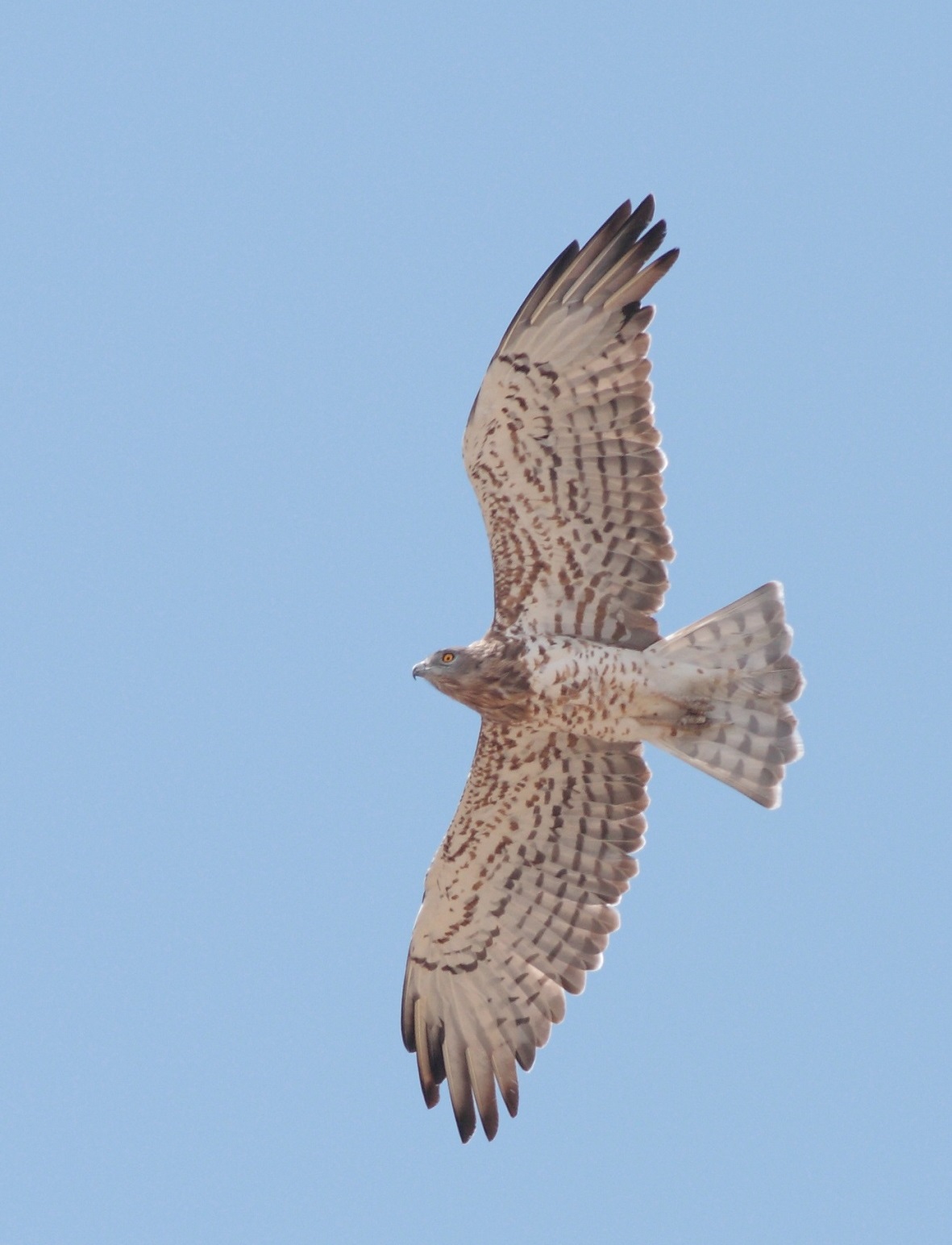
BOX I – Phylogeny
Phylogeny describes the evolutionary history of organisms, from which the relationships and evolutionary distances between genetically related groups of organisms can be derived. Such relationships give us an idea of how species or taxonomical groups share certain traits and to what extent they developed new traits over time. Owls and birds of prey, for example, share a common ancestor, meaning that they once originated from the same ancestor in evolution. That also means that traits of both owls and birds of prey once originated from the same position and therefore still can result in similarities to a certain extent. On the other hand, it reveals that from the same starting point quite some differences between owls and raptors have developed through evolution.
Within the order of owls (Strigiformes) two families are present: typical owls (Strigidae) and barn owls (Tytonidae).
Information in this special is presented from the owl’s perspective, based on several types of behaviour. Behaviour or morphological adaptations can be related to each other or not, dependent on a species’ lifestyle. The following species are represented in this special:
Barn Owl Tyto alba
Tawny Owl Strix aluco
Ural Owl Strix uralensis
Great Grey Owl Strix nebulosa
Short-eared Owl Asio flammeus
Long-eared Owl Asio otus
Eurasian Eagle Owl Bubo bubo
Pharaoh Eagle Owl Bubo ascalaphus
Snowy Owl Bubo scandiacus
Eurasian Scops Owl Otus scops
Tengmalm’s Owl Aegolius funereus
Northern Hawk Owl Surnia ulula
Eurasian Pygmy-owl Glaucidium passerinum
Little Owl Athene noctua

Let’s crawl into an owl’s skin, flying around on a hunt or sitting-and-waiting for prey. How can you actually detect prey, find a mate or navigate through your environment?
Owls have to detect cues from their surroundings all the time in order to move about and to prevent striking into trees or buildings. Moreover, in the dark, eyes are not sufficient to detect prey at large distances, especially if they are concealed. So how do you detect a prey at first?
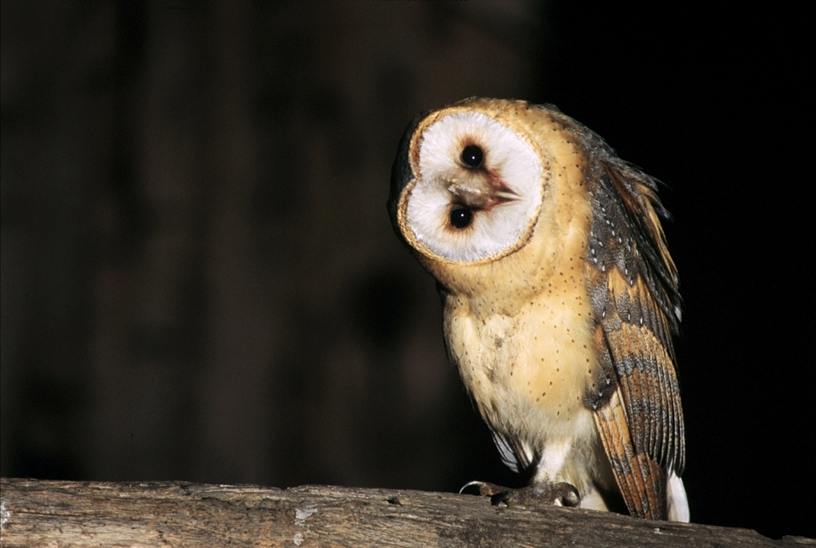
Senses
Hearing
The more an owl hunts upon hearing, the more specialised or adapted hearing features are generally needed. This also goes for owls hunting invisible prey, like voles under snow cover, which can be considered similar to hunting in the dark. Just like humans, owls have two ears, a left and right – but what is the purpose of having two ears? This can be explained using the figure below. If a sound is perceived from a certain direction, for example from the right of where the owl is, the right ear will pick up the sound slightly faster than the left ear.

By turning its head, the owl can change the position of its ears until the sound reaches the right and left ear at the exact same moment (figure). At that moment, the direction of where the sound originates from becomes clear. So, having two ears positioned on the sides of the head enables owls (and humans!) to determine the origin of a sound on the horizontal plane (left-right).

Most owls have a more specialised adaptation regarding the position of their ears: asymmetry. The shape and vertical position of the left and right ear slit of many owls differ, resulting in one ear being positioned higher on the side of the head than the other. This asymmetry can be seen in the shape and size of the ear opening in the owl’s skin or in its skull (photo). This difference in ear slit height allows owls to not only determine the origin of sounds in a horizontal plane, but also in a vertical plane! The next figure explains how it works: imagine an owl sitting on a fence pole hearing vole sounds below.
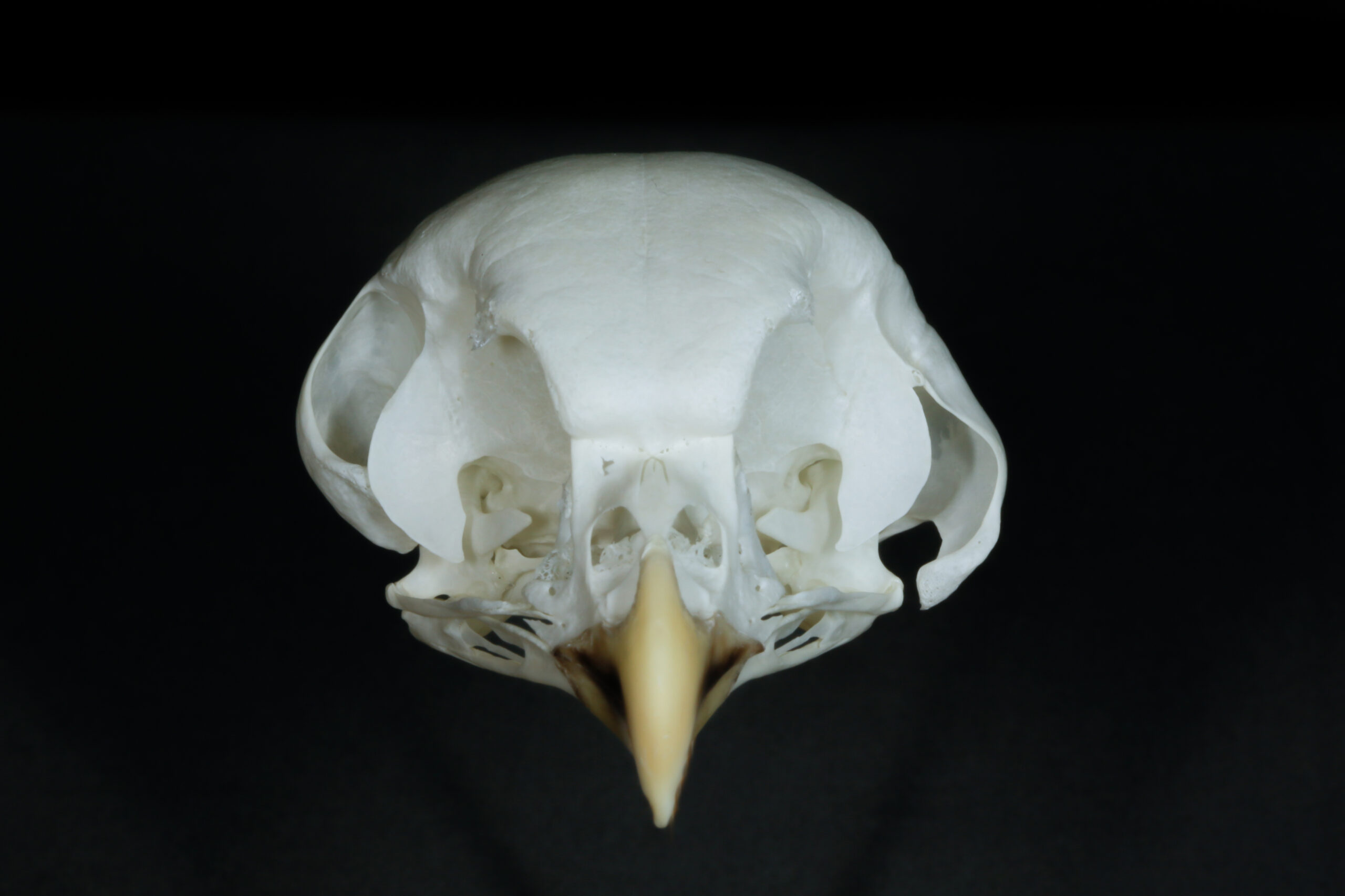
Like in the horizontal plane, a sound of the vole reaches the ear with the lowest position in the head just slightly faster than the ear positioned higher in the head. This means that the ear asymmetry provides owls with a vertical axis to determine a sound’s origin, which helps them estimate the angle of attack at which they have to fly towards their prey; when this adaptation is lacking, like in humans, it would be impossible to accurately determine the angle of approach to the vole.

Now, owls have some highly specialised adaptations in both internal and external structures of their ears, some of which are closely related to the ancestral relationships between species. All these morphological features and the degree to which they are developed play a role in the hearing capacity of owls and will be discussed next.
- Ear slit size
The first adaptation of owls that enables them to hunt upon hearing is quite straightforward: the size of the ear slits. Large ear slits (often in combination with other hearing features) allow more sound cues from the surroundings to be channelled towards the inner ear, resulting in more sounds or details being perceived. Compared to diurnal birds of prey (graph; grey triangles), owls generally have larger ear slits.
However, among owls the ear slits seems to have a large size variation (graph), and some species even have relatively small ear slits in comparison with birds of prey, like Eurasian Pygmy-owls. Zooming in on the variety among owls, it seems that a general relationship can be distinguished: owls hunting strictly nocturnal, like Long-eared Owl and Tengmalm’s Owl, have large ear slits.
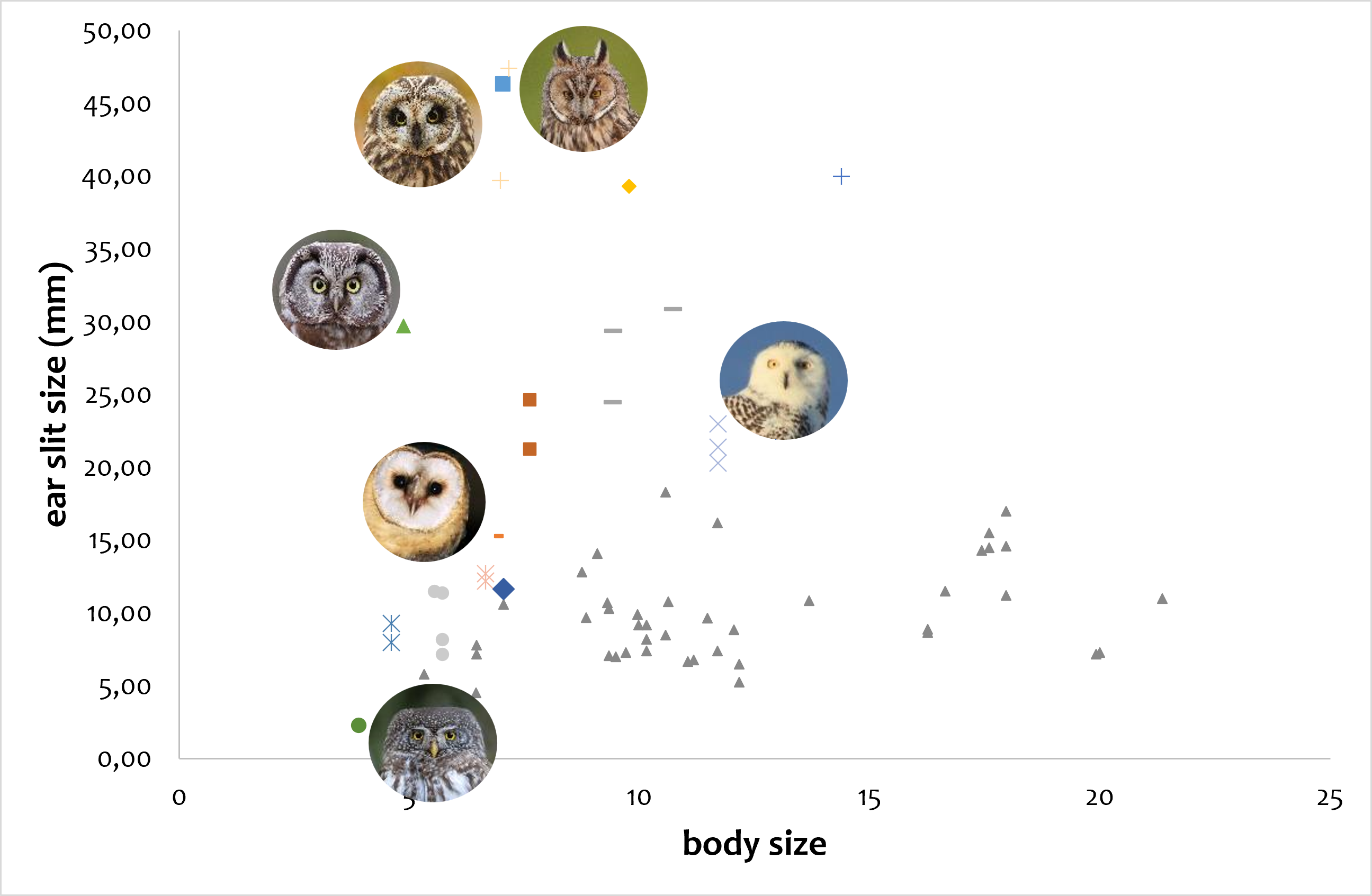
Strikingly, Short-eared Owls also have very large ear slits, although the species is primarily a diurnal and crepuscular hunter of densely vegetated areas. This indicates that the ear slit size can be large in closely related species with very different lifestyles, each species using its hearing adaptations to face different challenges.
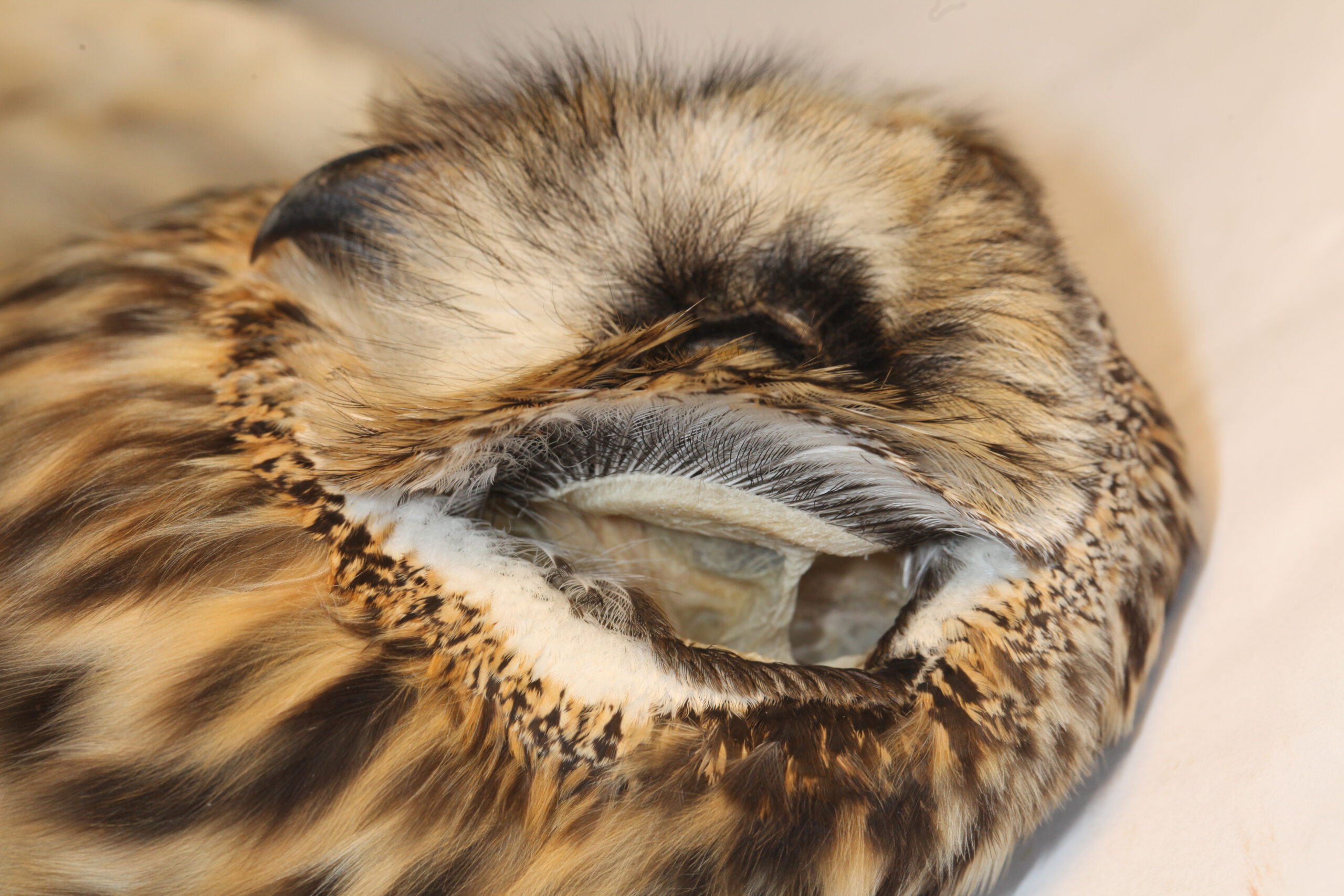
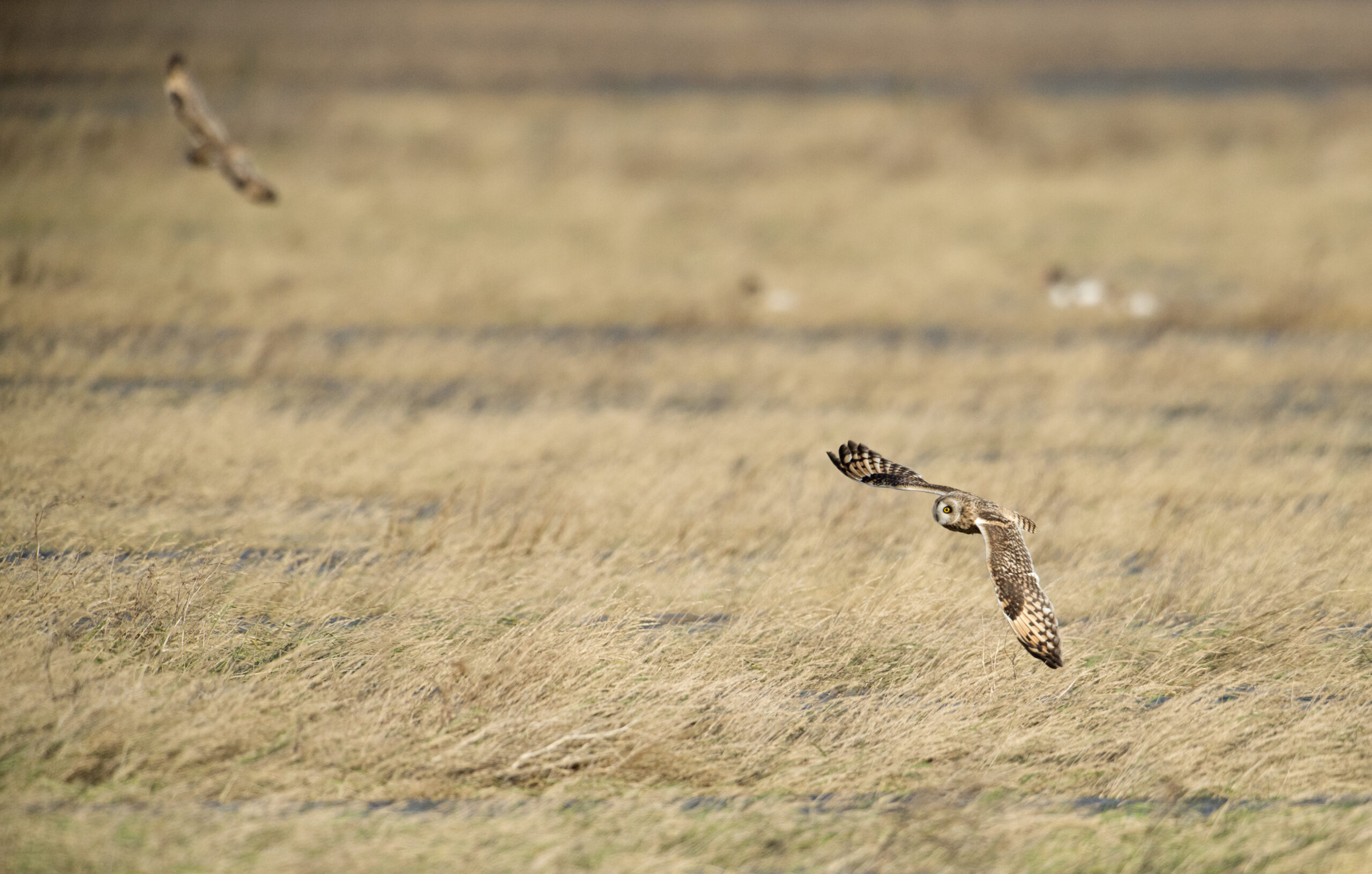
Other owls that tend to hunt prey in dense cover face the problem of high prey invisibility and therefore also seem to have large ear slits, regardless of being nocturnal or diurnal. An example of such a species is Great Grey Owl, which is mainly crepuscular but also known to hunt during the day and night. As these owls hunt rodents below a thick snow cover in certain times of year, their prey is invisible to the eye, forcing them to rely on highly adapted hearing to catch a meal.

- Asymmetry
The second feature is the functionality of asymmetrical ear slits, as mentioned before, which can have different types and which seems to depend on evolutionary and functional drivers. In Barn Owls, for instance, a slight degree of asymmetry in the height of the ear opening is present in the skin, whereas Tengmalm’s Owls show an extreme example of asymmetrical ear openings in the skull (photo; red circles). Both species heavily rely on their hearing to hunt and use functional ear asymmetry to do so, but in different manners. This is likely a result of their relatively large unrelatedness, evolutionary-wise.

A third type of owls, like Tawny Owl, does not actually show asymmetry in the height of the ears, but in the shape of the ear slit skin instead, which effectively gives them a similar functionality. An imagination of the asymmetry in the ear slit shape is slightly exaggerated here in a Tawny Owl (photo).
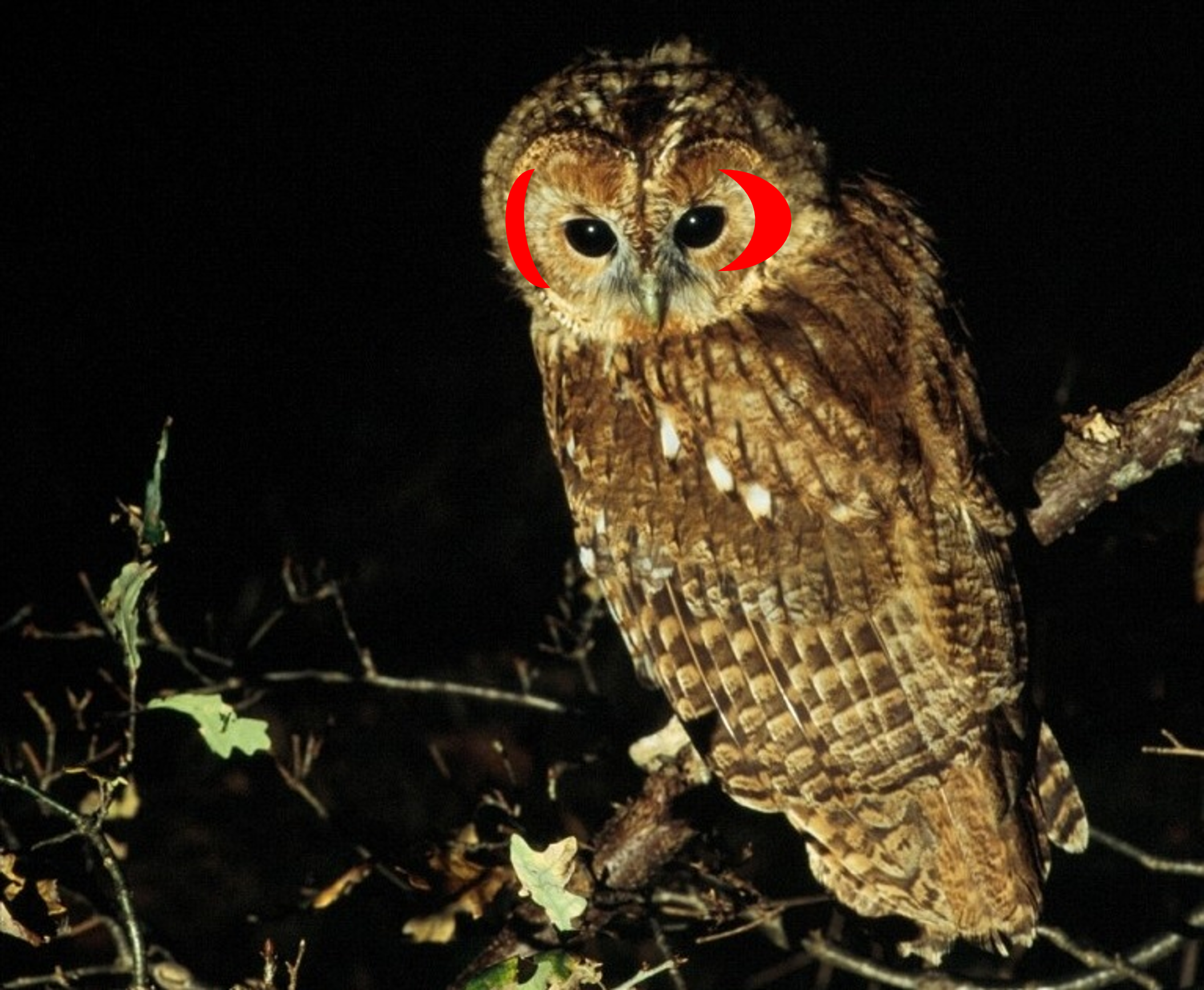
- Skin flap
Another feature is the skin flap found in some owls. Especially Asio owls, like the Long-eared and Short-eared Owl, have highly developed flaps in front of and behind their ear openings. Other owls can have (one or two) smaller skin flaps in a variety of shapes and sizes, like the Ural Owl here and most other Strix owls. The front skin flap covers the ear opening and is fringed with a fan of open-structured feathers, which together with the skin flap cancel direct noise from entering the ear opening. Hence, the hearing is not disturbed by direct, loud noises but can be focused on high-pitched prey cues instead. Owls that are less dependent on hearing – mainly diurnal eyesight hunters – can lack a skin flap completely, of which the Northern Hawk Owl is an example.

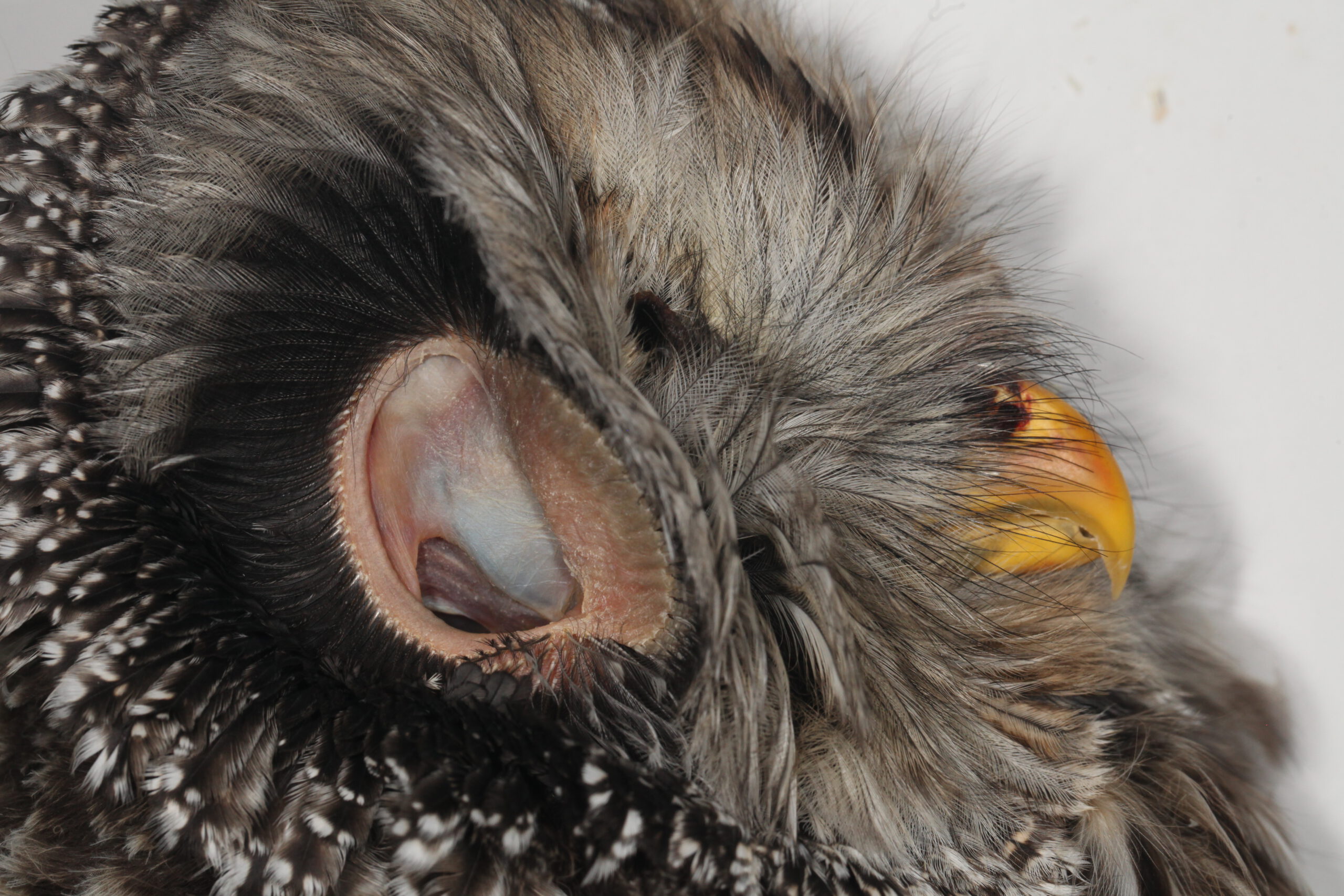
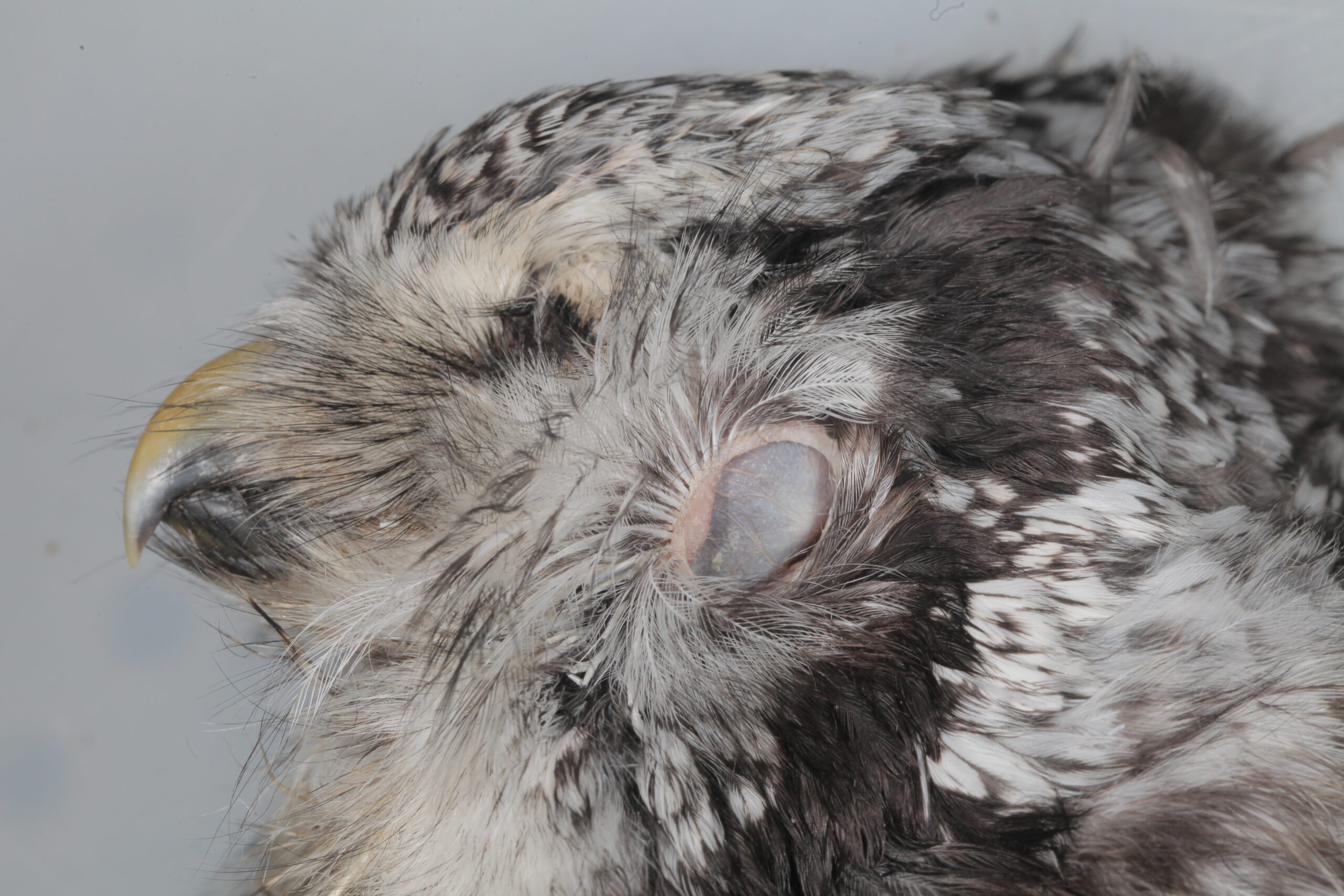
Combinations of the features above can be found regularly among owls. Interestingly, the hunting method and dominant prey also seem to cause certain adaptations to be developed or not. Eurasian Scops Owls, for example, show some degree of asymmetrical ear slits, but lack any other highly developed hearing or flight adaptations as found in other nocturnal owls. This suggests the ears to be restrictedly adapted to what scops owls need: estimating the distance to their prey in order to know the flight route (no filtering of sounds). Given the fact that they are mainly sit-and-wait insect hunters, they need less noise cancelling (silent & slow flight) or shorter reaction time to catch their prey. Insects probably detect a charging scops owl less easily than vertebrates would, which maybe lowers the risk of a prey being chased off by wing beats of scops owls.
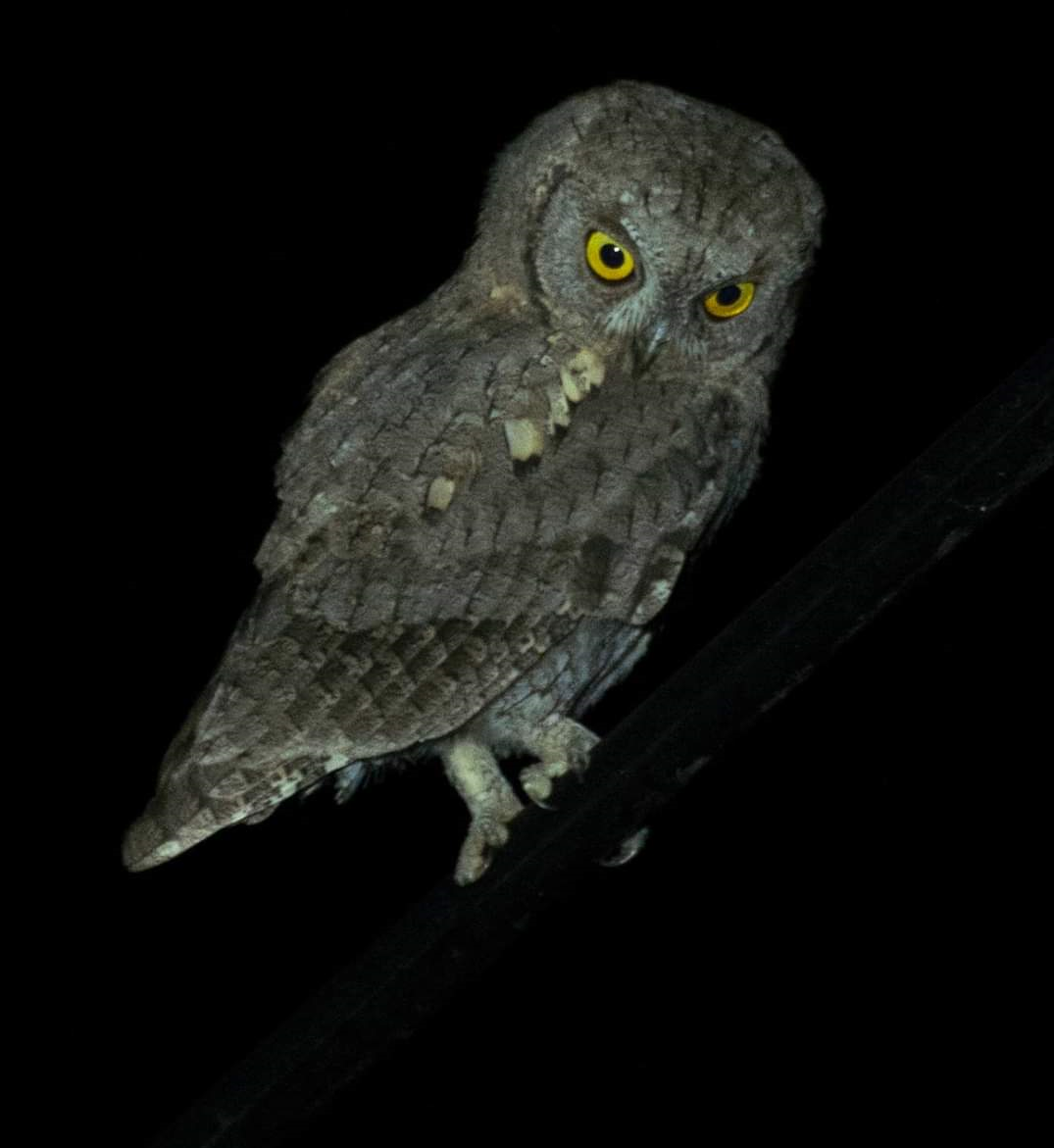
BOX II – Ears in raptors
It appears that some diurnal birds of prey can share owl-like adaptations. Hen Harriers, for example, have a feather collar, which is a characteristic often referred to in harrier identification. After removal of the feathers, this collar appears to be a skin flap behind the ear (in blue) with a similar application as in owls, increasing their hearing capacities compared to other diurnal raptors! Hunting upon hearing can be beneficial for harriers, as their prey often remains unseen in very dense vegetation cover of grasslands or marshes. Although harrier ears are not as developed as owl ears, they do have similar adaptations for the same challenge and therewith show the ecomorphological variation among diurnal raptors too.
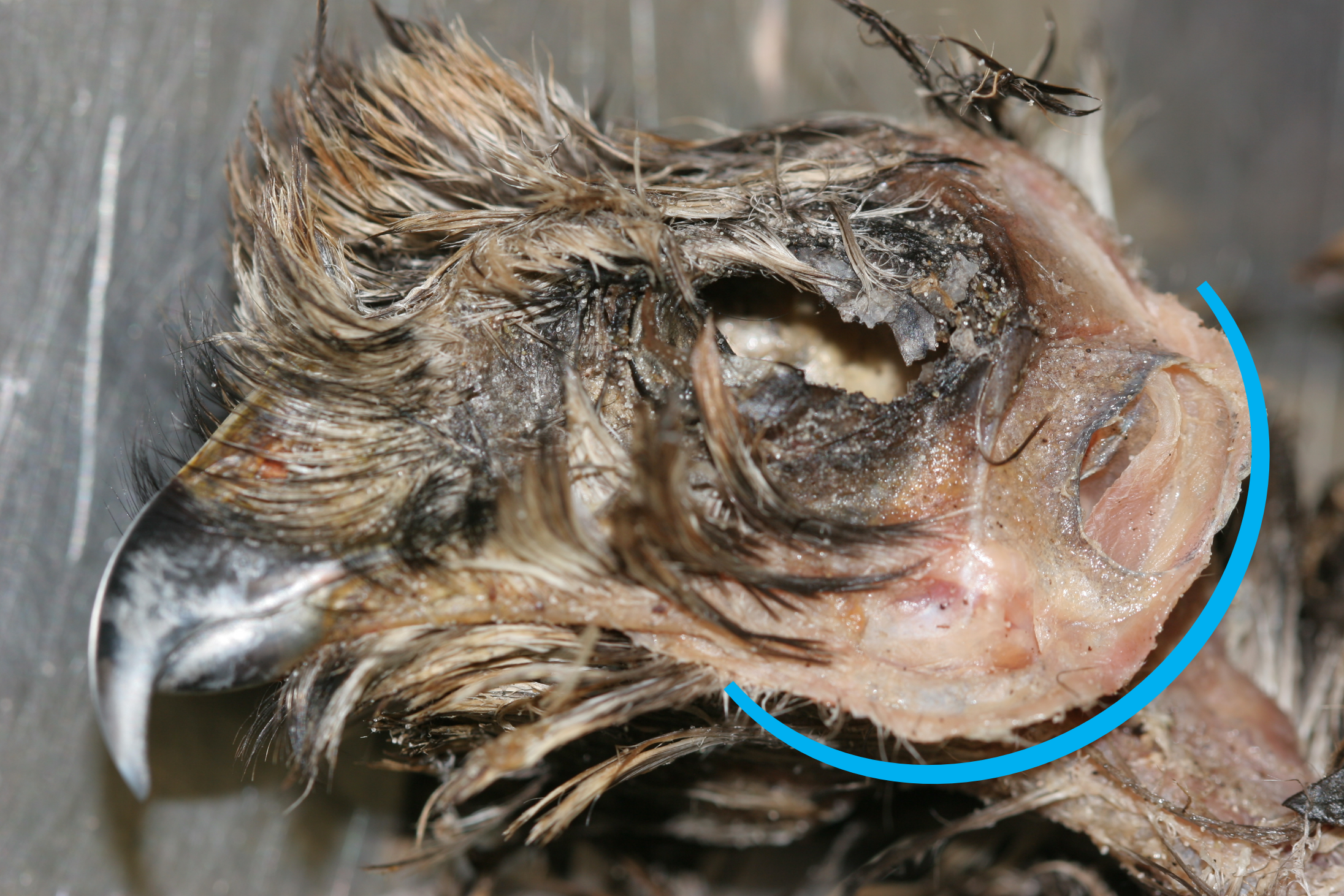
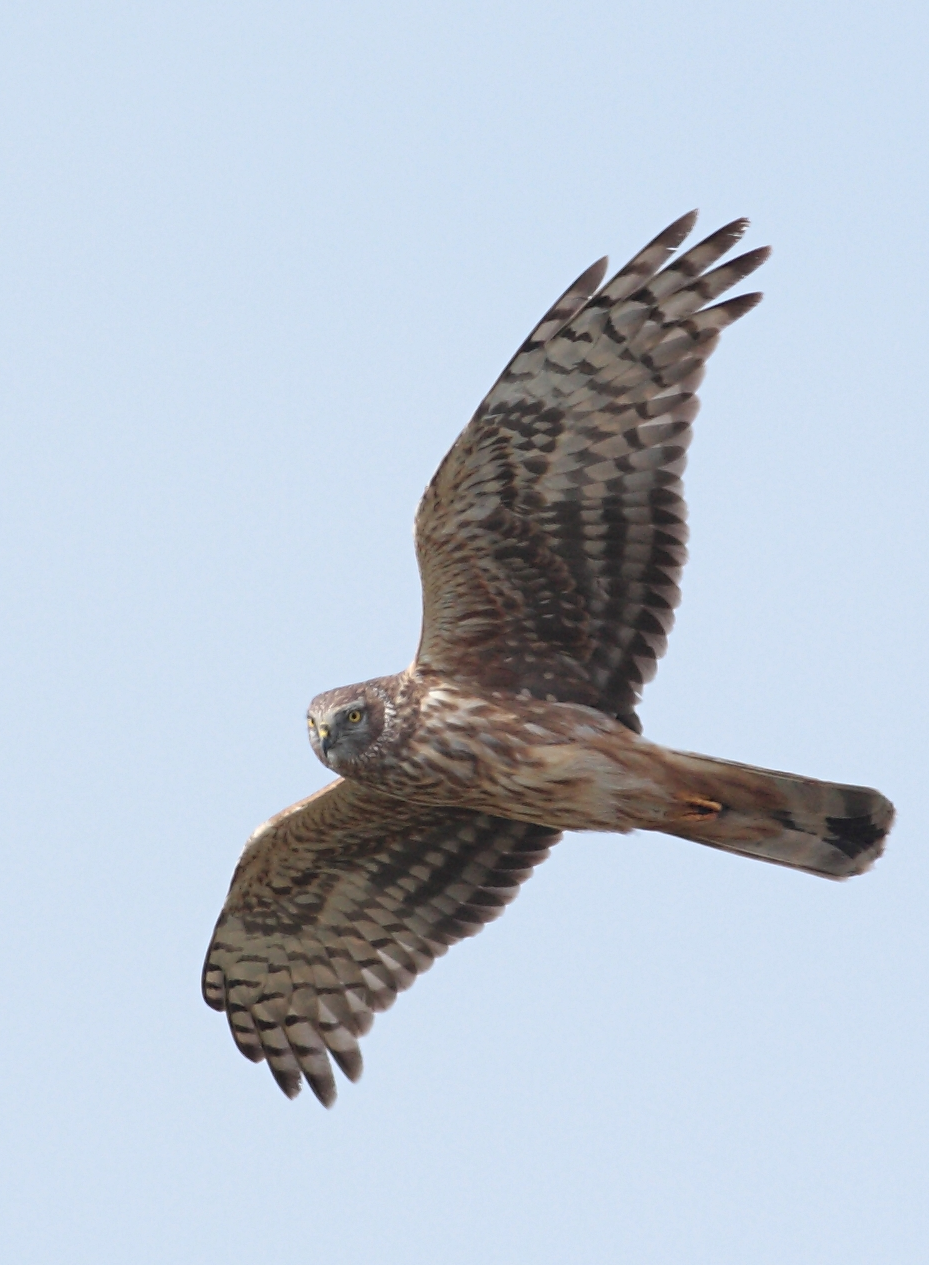
- Facial ruff
A third aspect is the development of the facial disk or facial ruff, which often gives owls their distinctive looks and impression. The facial disk can be highly specialised, like in Great Grey Owls, but also lacks in some species, like in Little Owls. The presence of a functional facial disk is linked to what prey is hunted and where and is also highly dependent on the evolutionary origin of a species. The facial disk has an almost parabolical shape around the ears and consists of two main parts: 1) dense feathers behind the ear (red), enlarging the ear surface for the owl to pick up (more) high-pitched sound cues, which are then reflected towards the ear opening; 2) one or two rows of open-structured feathers (yellow), covering the ear opening and possibly filtering noise from the surroundings together with the skin flap, enabling the owl to filter prey cues better.
So, the skin flap and facial disk enable owls to filter out low-pitched sounds and reflect high-pitched sounds to the ear opening better. This results in hearing prey cues better and hearing less noise from wind or their surroundings!
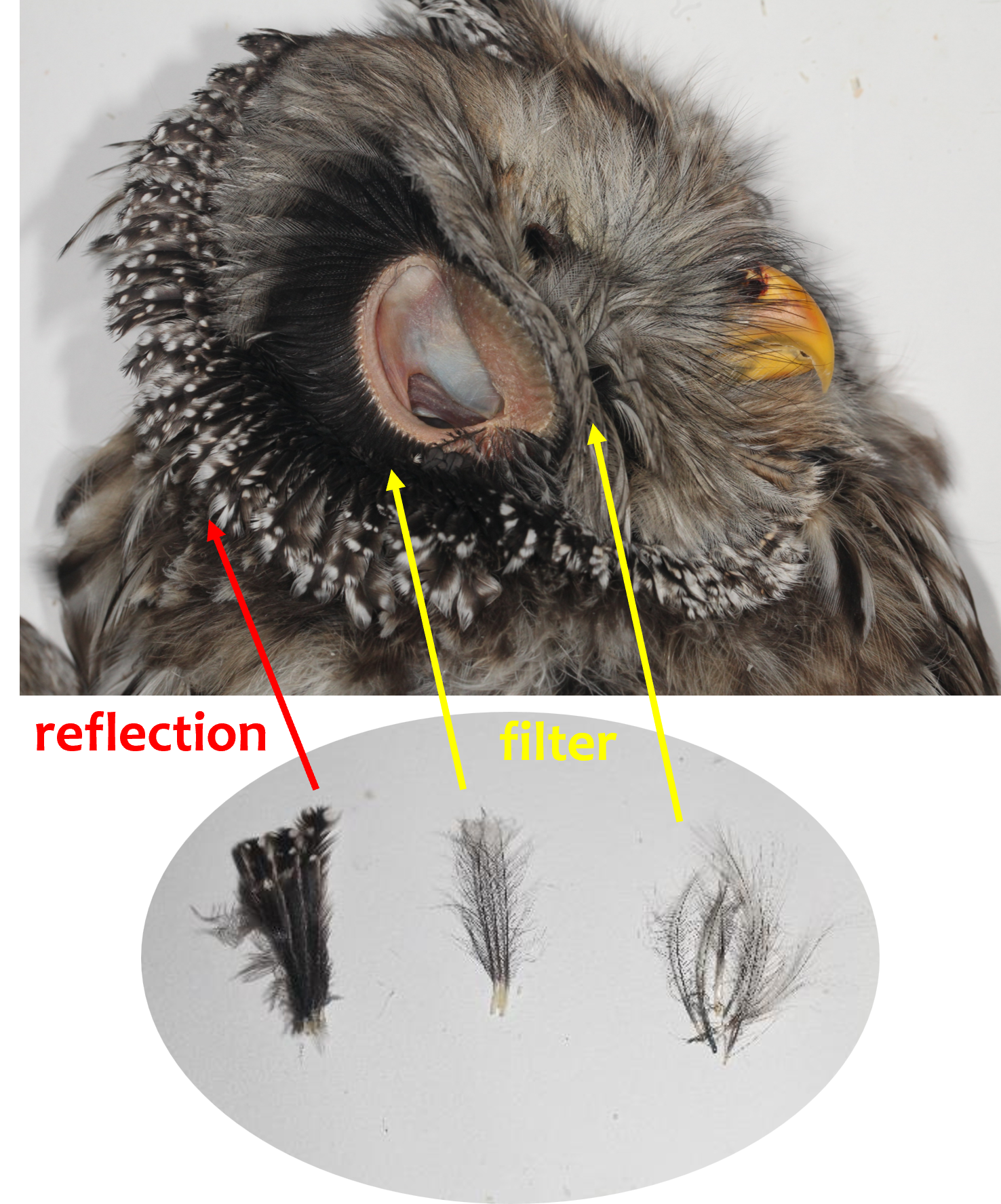
Looking back at the graph now, it seems that two main groups can be distinguished among owls:
- Species placed high in the graph compared to other owls have both large ears and morphologically specialised ears
- Species without special ear adaptations are placed low in the graph compared to other owls
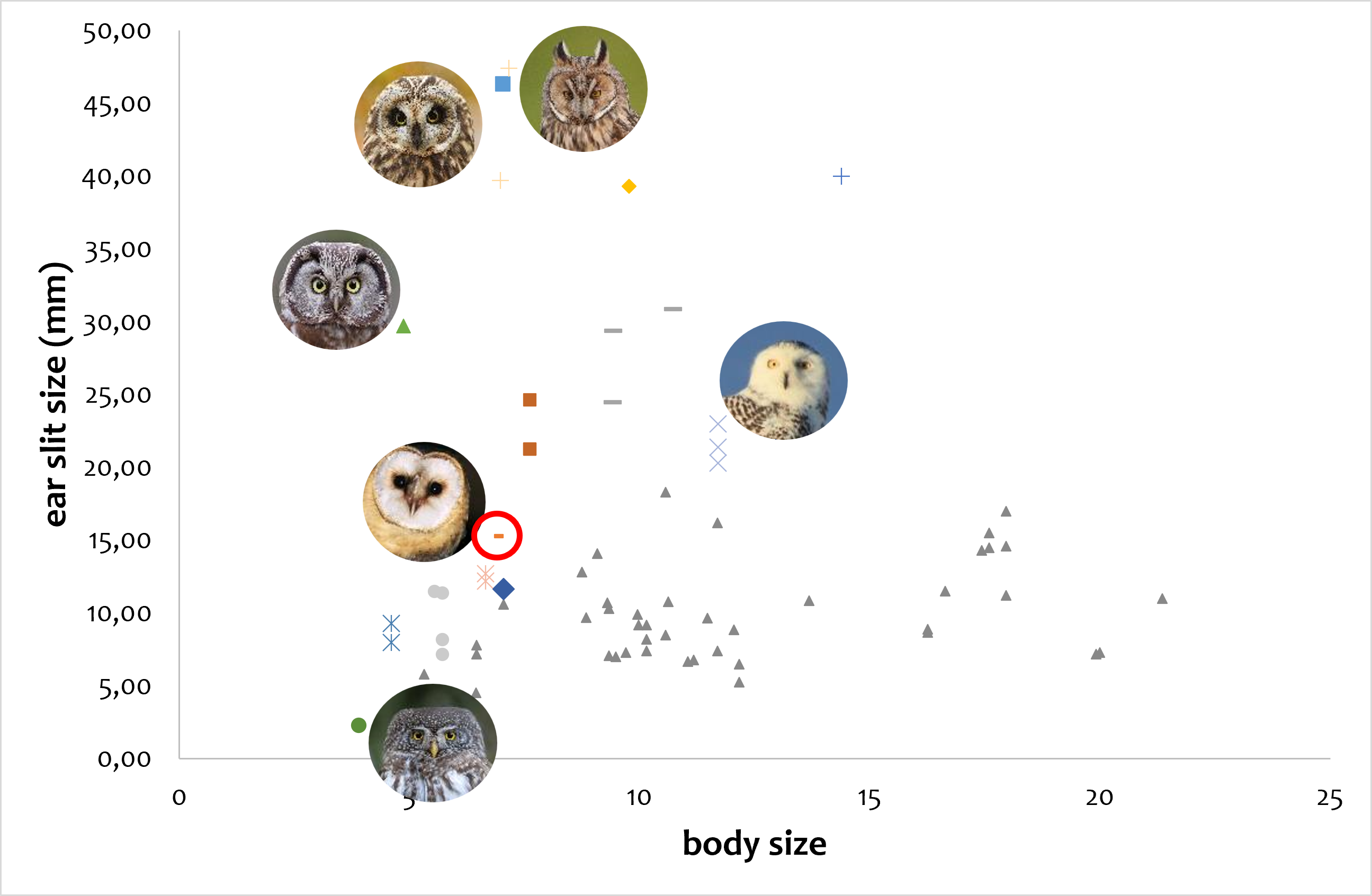
Although Barn owls are strictly nocturnal hunters, they seem to have relatively small ear slits given their position in the graph (red circle). Looking at more aspects of their ears in an integrated way it becomes apparent that their ears look quite different than in all other owls.
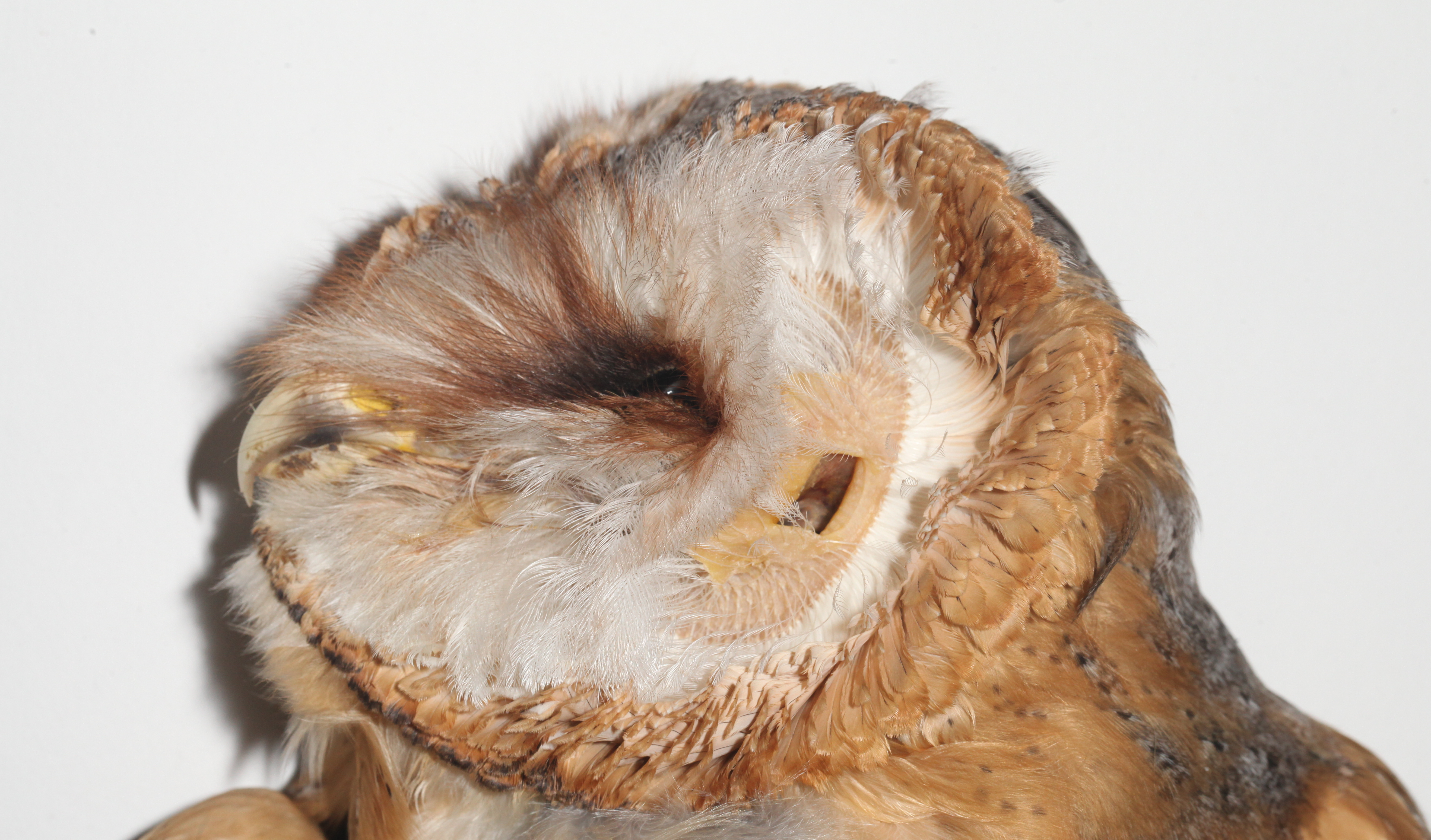
The ear slits of Barn Owls have a very distinctive, almost rectangular shape and a skin flap as seen in no other owls, covering the front of the ear to filter out direct sounds, making them still highly specialised in nocturnal hunting upon hearing. An explanation could be that Barn Owls belong to another owl family than all other owls studied here. Given that, it is most likely that their unexpected position is a result of the different phylogenetic backgrounds, resulting in a different ear structure that is not fully comparable with owls from the other family. The example above underlines that morphological features should be treated in an integrated way with the lifestyle and evolutionary background of species taken into account.
Owl hearing in a nutshell
Owls are unique in showing a wide array of morphological hearing adaptations, of which the main features are: 1) large ear slit size, 2) asymmetrical ears, 3) skin flaps around the ear slit and 4) a facial ruff. The degree to which each of these adaptations are developed and the combination of them results in a sort of ‘hearing toolbox’, indicating how well an owl is specialised in hunting upon hearing. These tool sets vary quite a lot between species and relate to factors as the time of day an owl hunts, the hunting strategy, the type of prey and the environment an owl lives in. Prey can be invisible to the eye due to darkness, but also as a result of vegetation or snow cover. In that regard owls (and raptors like Hen Harriers) hunting in daylight face the same challenge in prey detection as nocturnal hunters.
Overall conclusion: the most specialised ears are found in owls hunting visibly hard-to-detect prey, regardless of their evolutionary relatedness or of being nocturnal of diurnal.
So, detecting a prey can be quite a challenge, either because light is lacking or due to dense cover in which prey have to be located. In case of most owls, including Barn Owls, they detect prey upon hearing, which solves both challenges. So, it seems that owls make use of the adaptations they have to perform well. This, however, does not necessarily have to be hearing, but can be eyesight as well.
How is the interplay between hearing and eyesight in owls actually?

Eyesight
The hearing adaptations mentioned above offer owls a unique and very specialised hunting technique in the dark. However, they do take up much space around an owl’s head, which leads to certain limitations in the owl head morphology. Especially the facial disk and skin flaps would block a large part of an owl’s view if the eyes would be positioned on the sides of the head, like in birds of prey and other birds (left), restricting the field of view significantly (red triangle). Instead, owls have their eyes positioned towards the front, resulting in a binocular and much less restricted view (right).

Most probably, this is the result of the highly developed hearing adaptations, forcing the eyes to change position over time through evolution. In comparison, from the perspective of diurnal birds of prey there is no need to place the eyes in front of the head as their hearing apparatus is far less developed.
So, it seems that owl heads are broad in order to fit both an extensive hearing system and large eyes in the skull. To find out if the hearing system caused the eyes’position to have changed in owls, we take a look at the orientation of eyes in other nocturnal birds. An example are frogmouths, which hunt insects and small vertebrates upon eyesight at night and lack specialised hearing features.
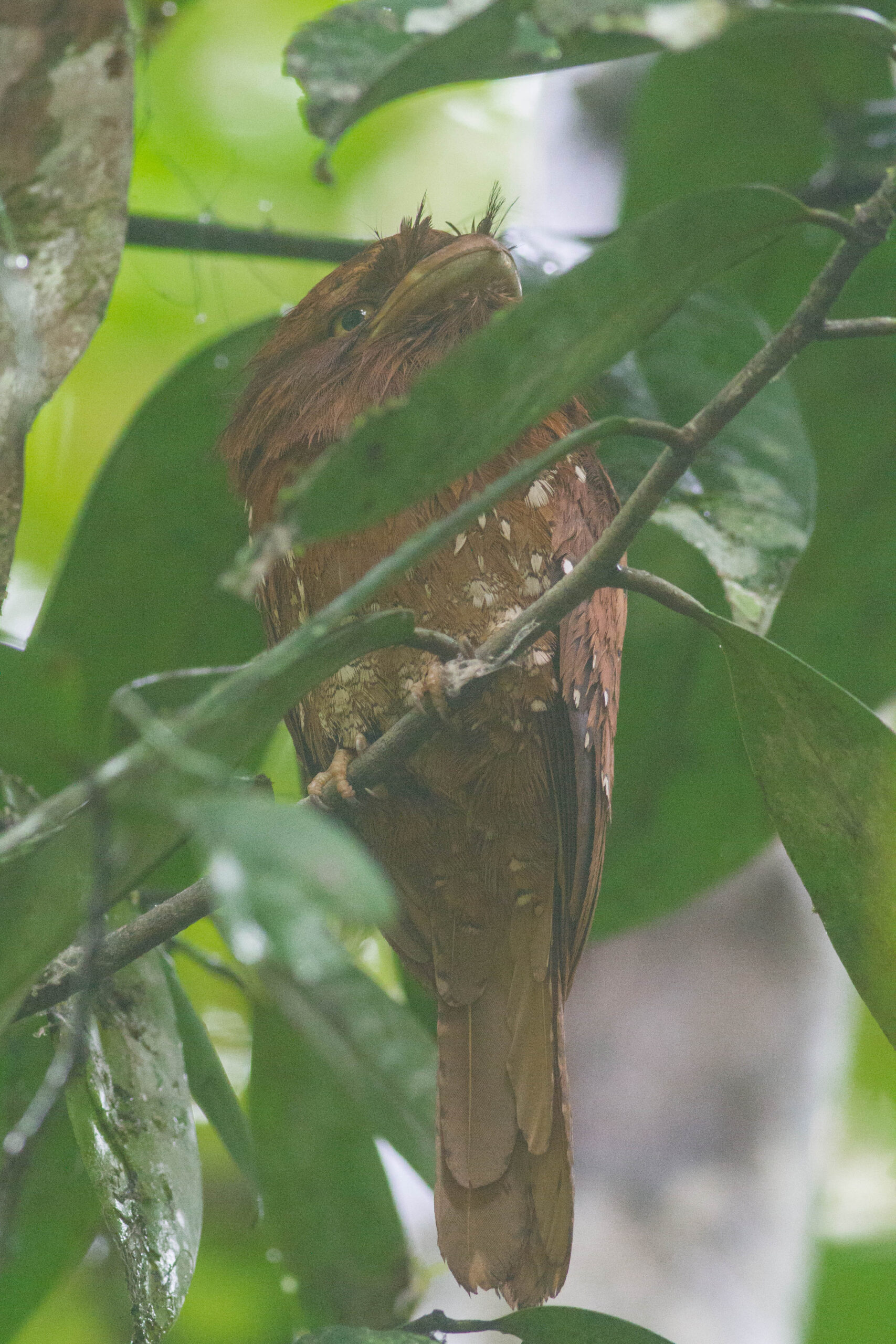
When comparing the skulls of a frogmouth (left) and an owl (right) from above, it becomes clear that the angle at which the eyes are placed in the skulls is quite different. It also shows that the wide skull of frogmouths is clearly not a result of the orientation of the eyes, but of the wide beak instead, enabling them to catch and swallow large prey. This comparison suggests as well that the hearing adaptations of owls indeed seem to have resulted in a more forward-facing orientation of their eyes.
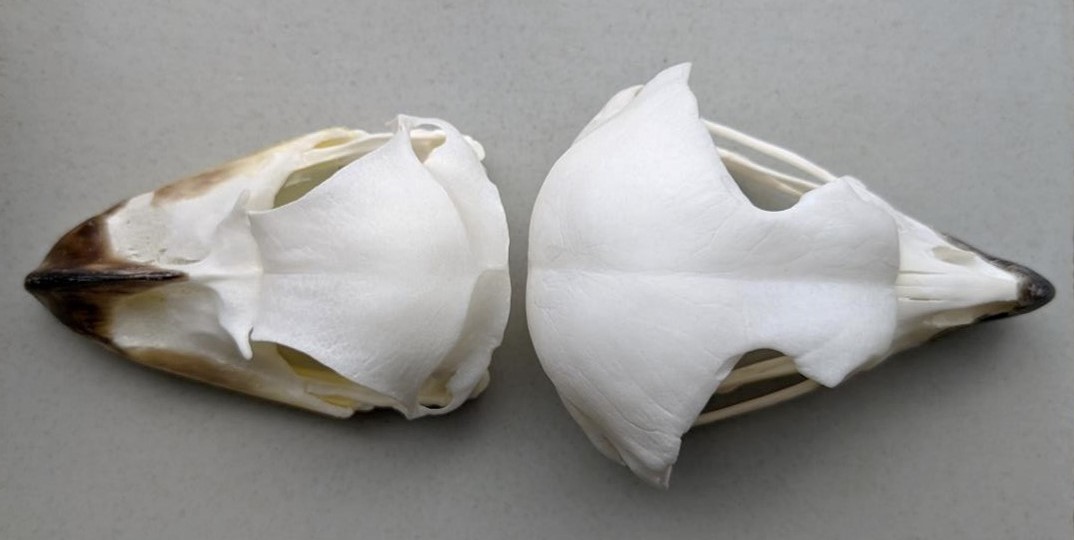
BOX III – Myth busting
Probably the most famous story about owls tells that they are unique in their ability to spin their heads up to 360 degrees. But is that actually true?
Given their fixed eye position and a highly binocular view, it is evident that owls are forced to turn their heads in order to look around, as their eyes are not able to move inside their sockets, unlike human eyes. Moreover, their ears also have to be pointed in the direction of a sound source to locate it. So, when an owl wants to point its senses, it has to turn its head. Besides, owls have more neck vertebrae than humans, which is the actual reason that they can spin their necks much further than an average mammal. So, their necks allow the majority of this rotation.
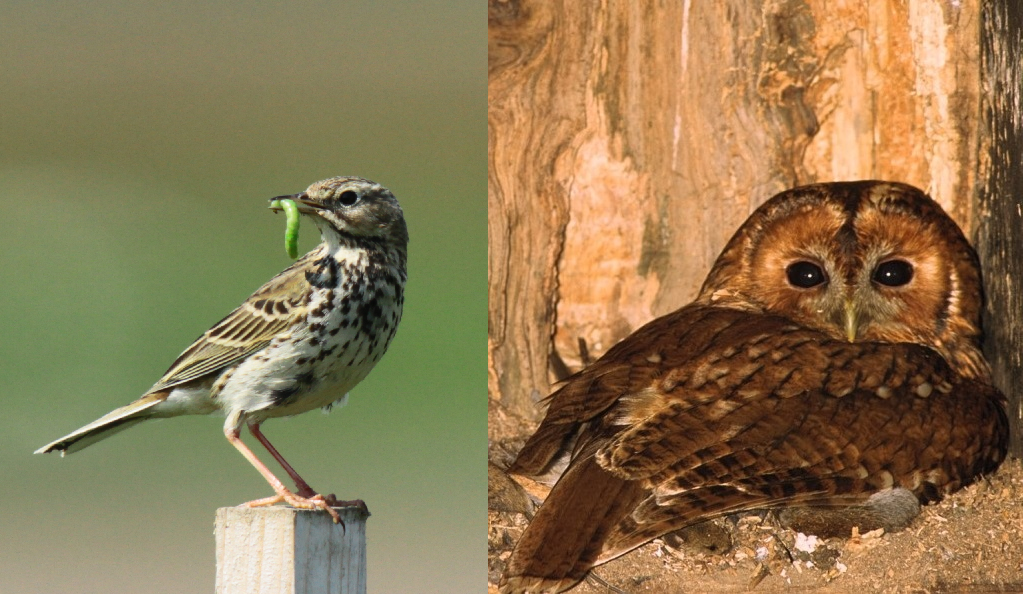
However, in this aspect owls are not different from other birds (foto)! A thick layer of feathers on the neck and head masks the neck movement, making it seem like an owl can twist its head much further than other birds! So: myth busted!
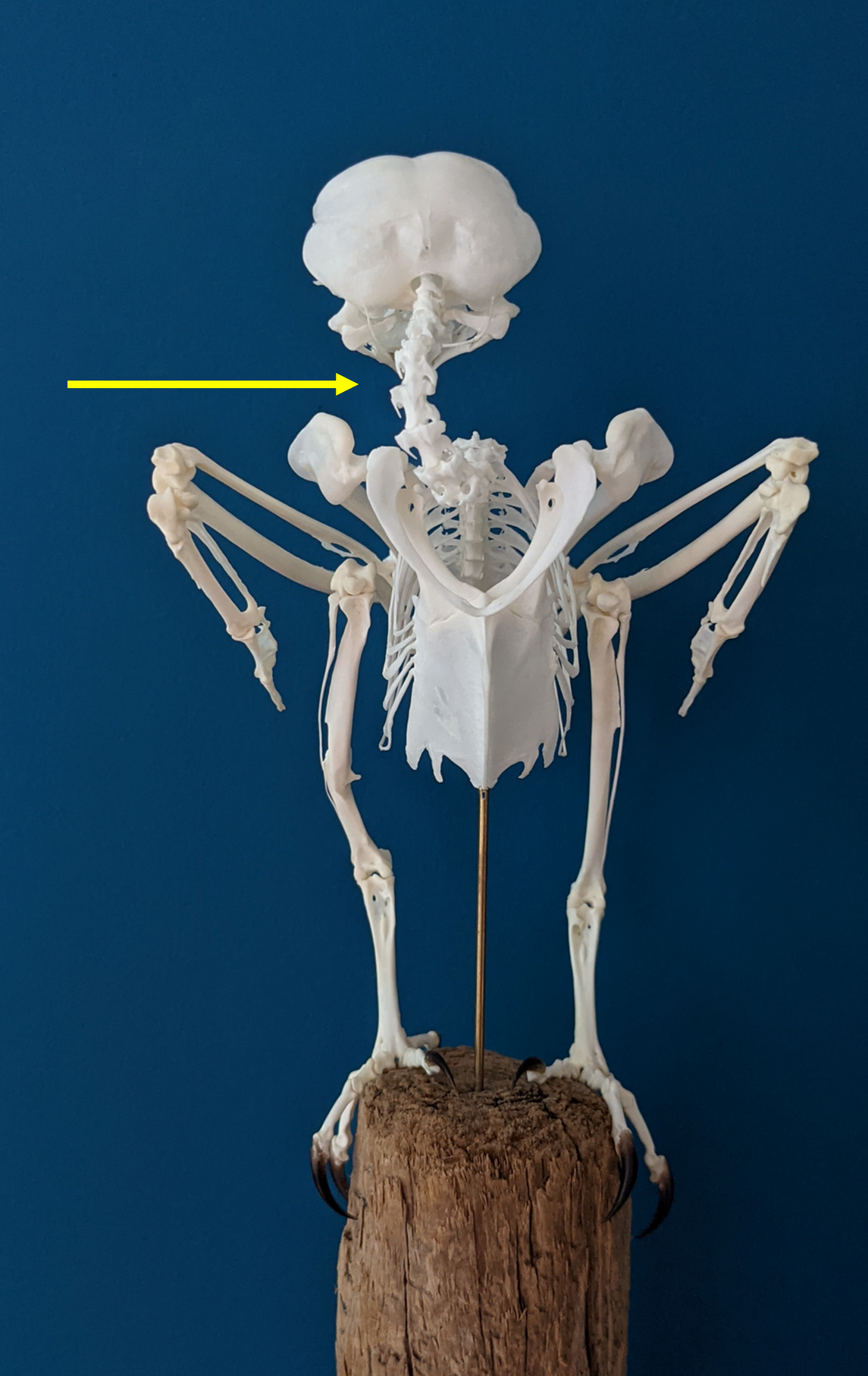
Besides being positioned towards the front, owl eyes are often said to be very large. When comparing eye sizes with those of diurnal birds of prey (graph), owls actually appear to have similar eye sizes – relative to body size – as raptors! Yet, the evolutionary driver for raptors and owls to both have large eyes is quite different. In owls, large eyes are needed in order to catch enough light to operate in low-light conditions, whereas in raptors it is all about creating a larger eye surface and therewith sharpness (high resolution) to get a razor sharp image of prey at long distances.
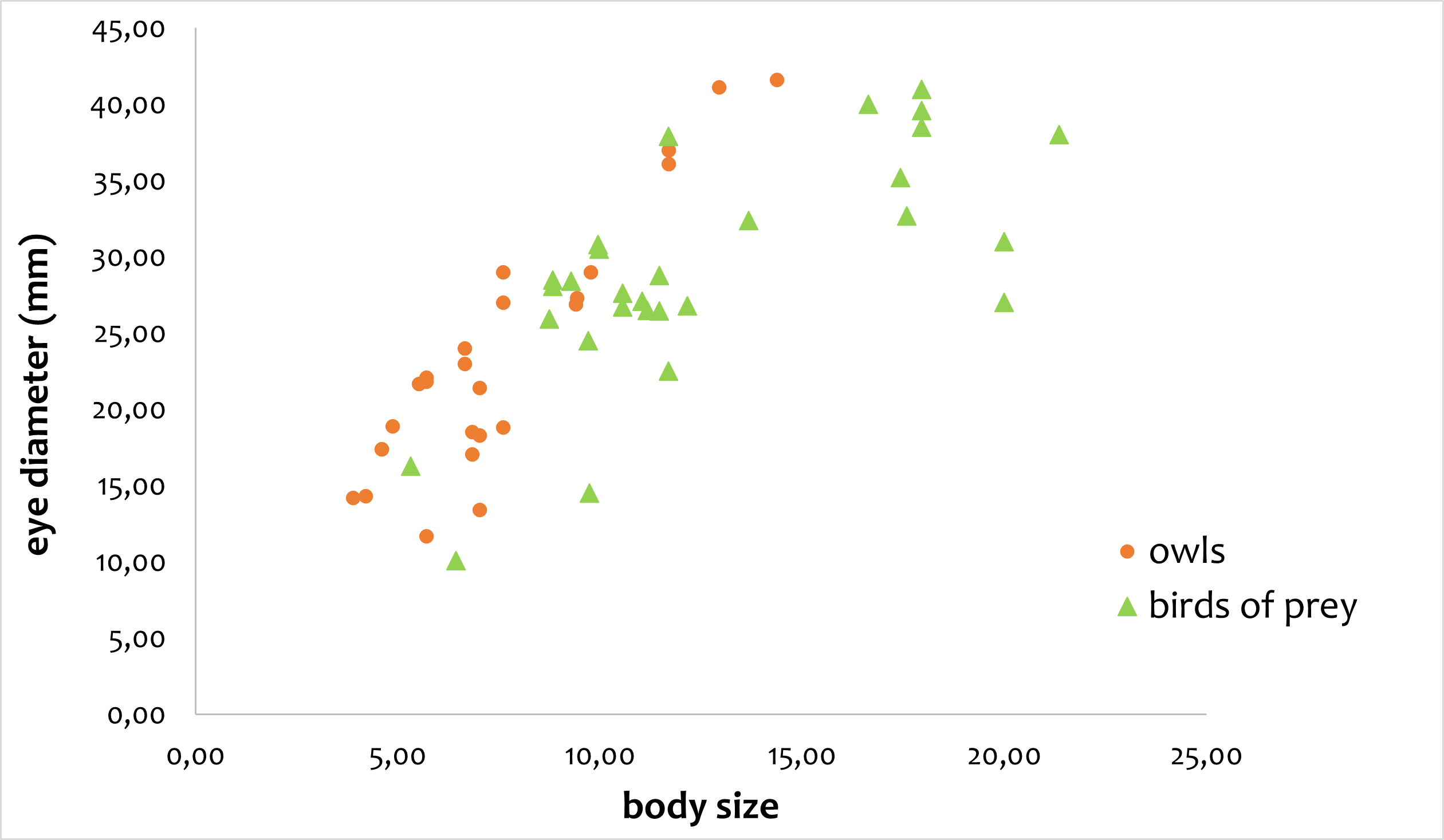
Owls even sacrifice part of their resolution in order to see better in low-light: their eye rods, photoreceptor cells in the eye retina, are bundled (indicated in red in figure). Bundling the eye rods lowers the threshold of light needed to send a single signal to the brain. This results in a lower amount of light needed to perceive a view and therefore helps owls to see in dim light. As a consequence, the total number of rod signals creating an image is relatively low in owls, resulting in a low resolution (low sharpness). In contrast with owls, in diurnal raptors every individual eye rod transfers a signal to the brain (figure), resulting in a much higher resolution.
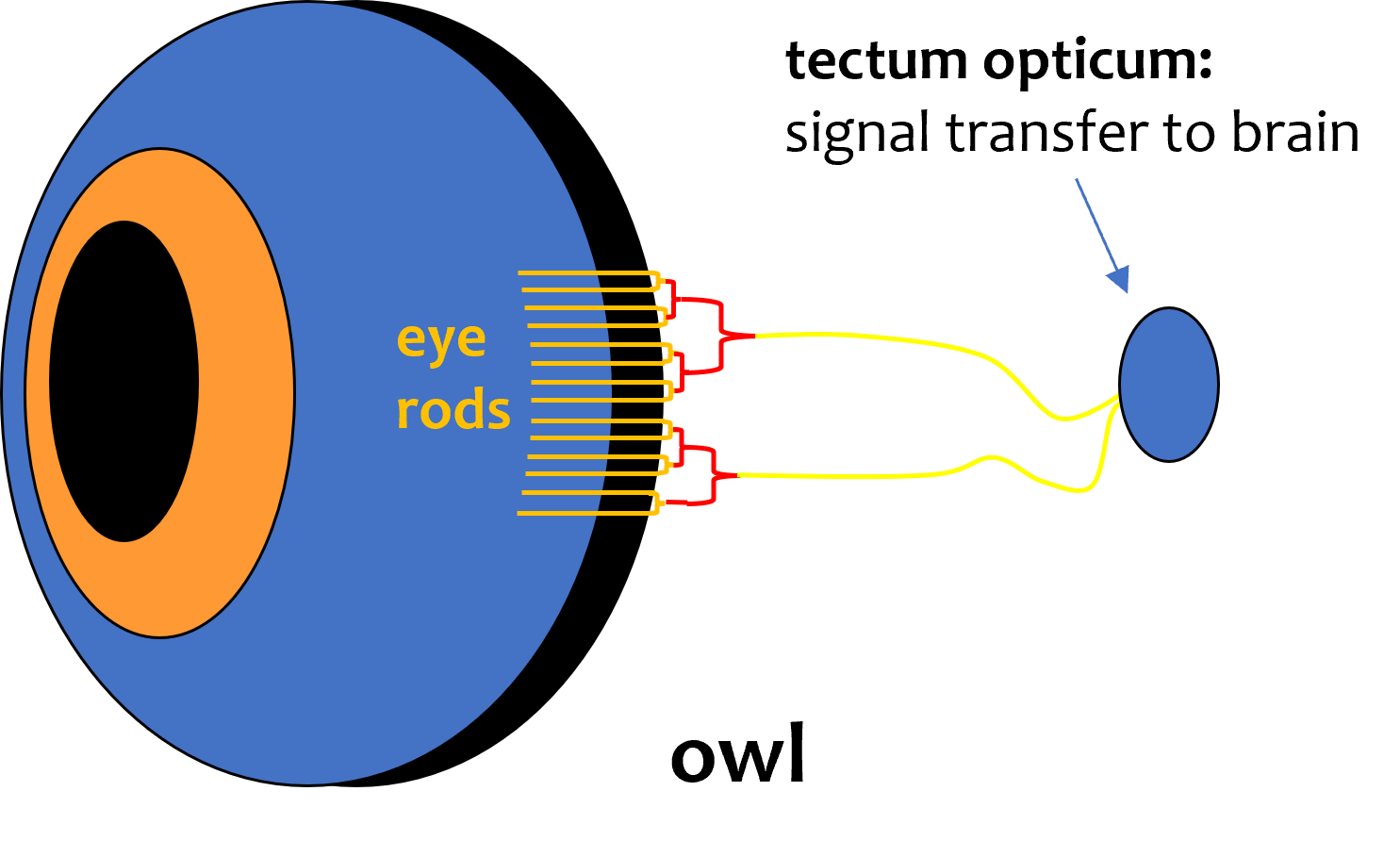
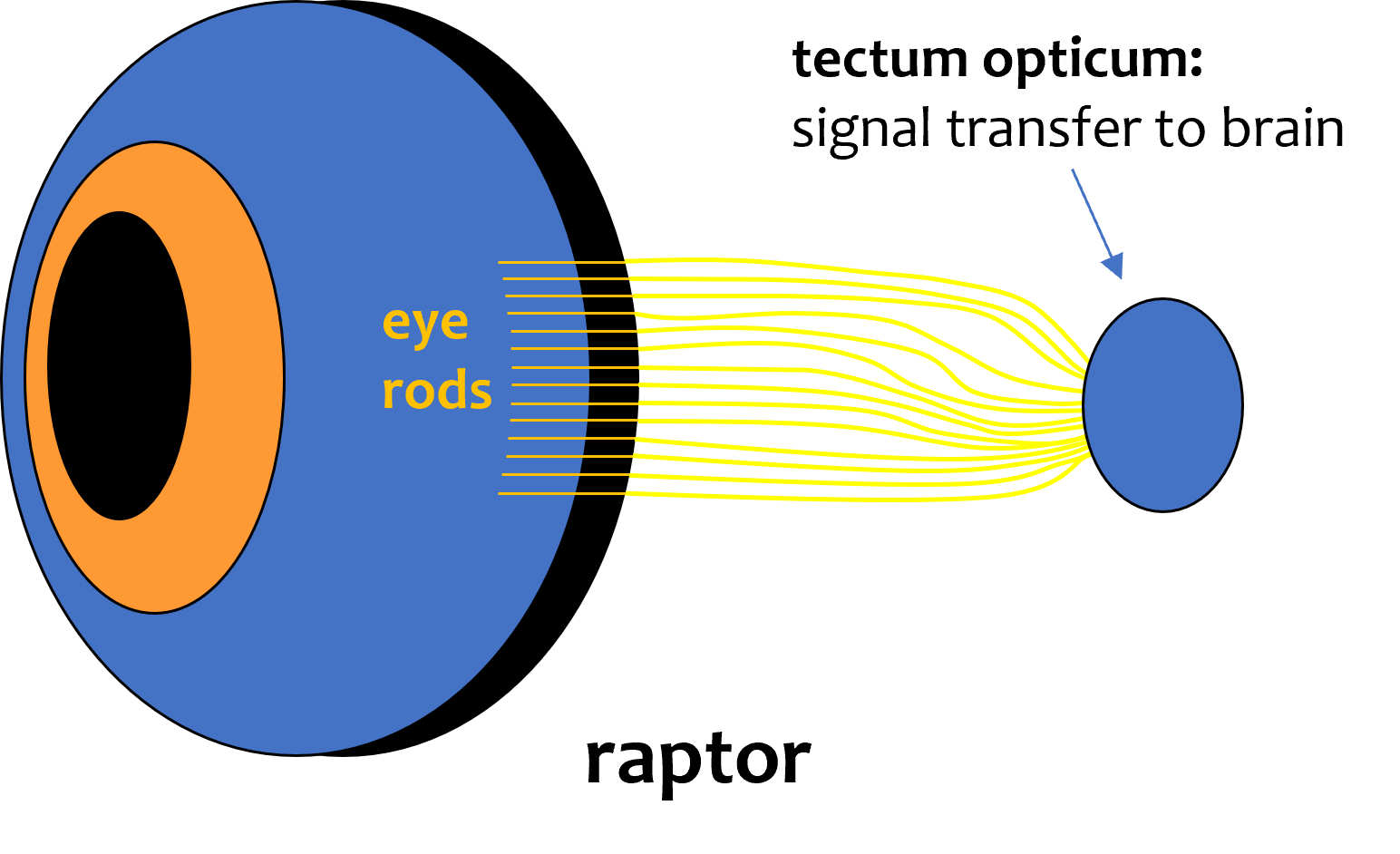
This can also be seen when comparing the brain of owls and raptors: the size of the tectum opticum (red circles), the centres in which visual information is processed in the brain, is relatively small in owls compared to raptors. That is because relatively little signals are to be passed through as a the result of the bundled rod cells in owl eye retinas.
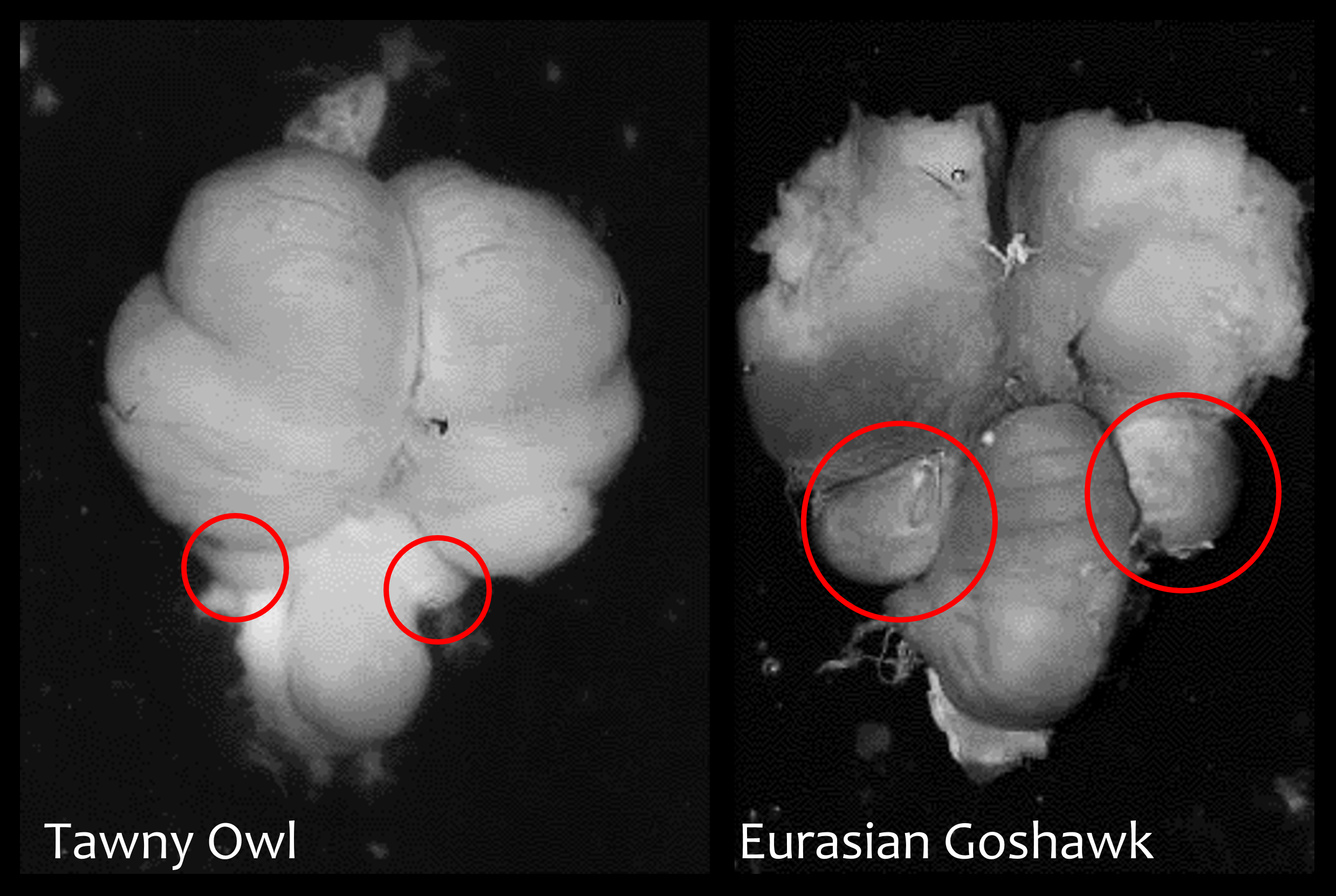
Another brain-related feature of the eyesight of owls is that their hearing nerve branches off to the optical centre (tectum opticum) before it continues to the audio centre of the brain. The dashed yellow line in the figure indicates how this should be organised in the owl’s brain.
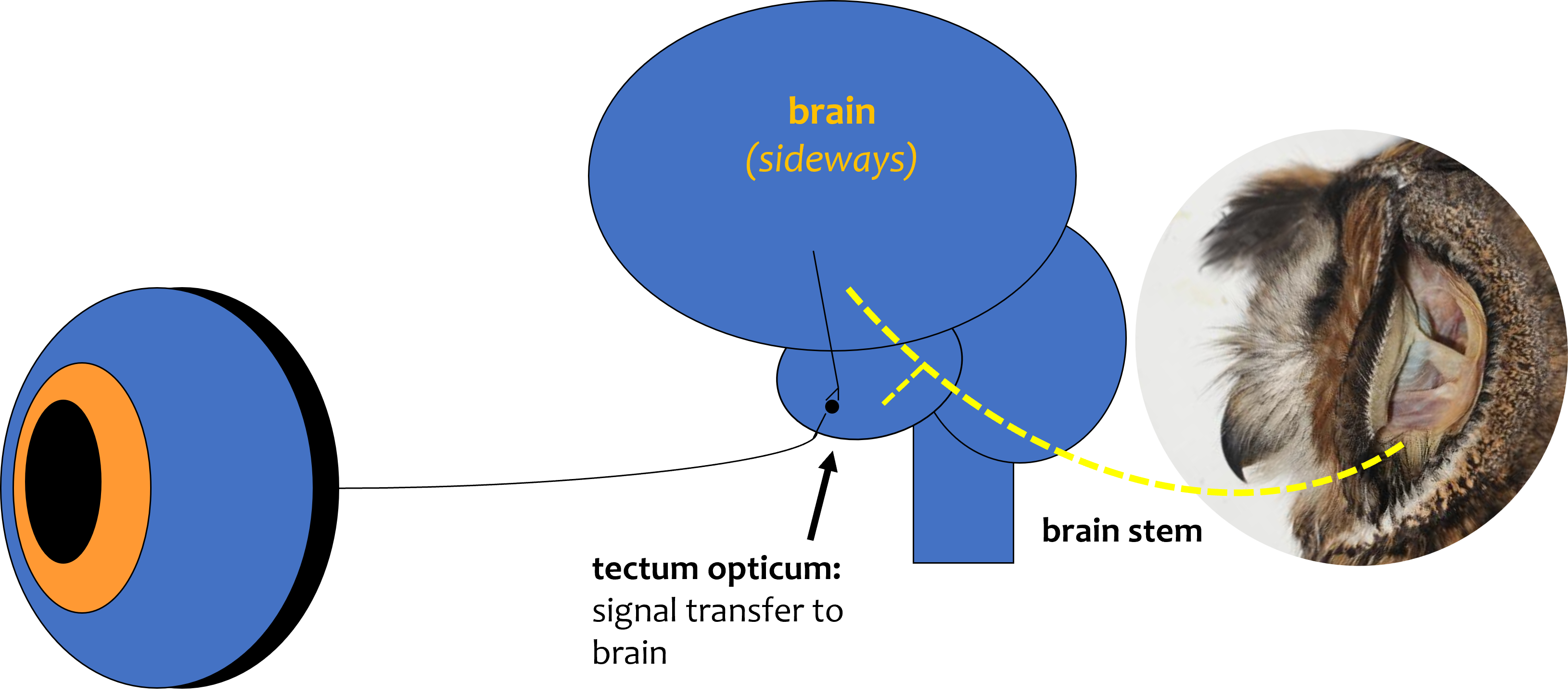
This suggests that owls might be able to create a visual perception of where audio cues are located! In other words, they could be able to “see” where sounds come from in their environment. This can be imagined as looking over a forest patch (photo), in which the owl does not see a mouse – even in daylight – but it does “see” where the sounds of the mouse are coming from, both in light and pitch dark conditions.


Owl eyes in a nutshell
Owl eyes seem to be positioned in a binocular orientation as a result of creating space for specialised hearing adaptations. This forces owls to turn their heads in order to point their ears and eyes for orientation. Owls have a larger number of vertebrae than humans, allowing them to spin their necks quite far – obscured by a thick layer of feathers – and therefore keeping their head-turning myth alive. Owl and raptor eyes are both very large, but for different reasons: owls need large eyes to catch enough light in dim light, whereas raptors need the size to create a sharp view. Owls even sacrifice part of their resolution in order to improve vision in low-light by bundling rod cells in their eye’s retinas. Part of the audio information of owls is processed in the visual centre of the brain, suggesting that owls may be even more specialised by “seeing” where sounds come from in their environment.
Let’s crawl back into the owl’s skin again. For instance, imagine being a Barn Owl flying over a meadow in windy weather at night. You suddenly detect a shrew upon the sounds it makes from the cover of dense vegetation. To reach it, you have to approach it on the wing.
To minimize the noise of your own wing flapping you must fly silently. How?

Flight
Owl feathers are unique because of a distinctly soft and fluffy texture on the surface of most feathers and hair-like structures on the inner vane of their flight feathers. The leading edges of the outer primaries also have a comb-like row of barbules, called serrations, which aid in silent flight (photos below). The main function of these serrations is to force the air layer flowing over the wing to stick to the wing surface better, retaining the so-called laminar flow and minimizing the air drag over the wing. Drag along the wing causes noise, so lowering the drag also reduces noise produced by the owl’s flight.

These examples (A-F) indicate that owl species hunting in-flight by using their hearing system to catch prey tend to have higher developed serrations and fluffy wing surfaces (D, E, F) compared to species that hunt by foot (A) or upon eyesight (B, C) to quite some degree. Owls that depend on their hearing for either nocturnal hunting or diurnal hunting probably both benefit from the serrations as they aid in minimizing noise in flight.
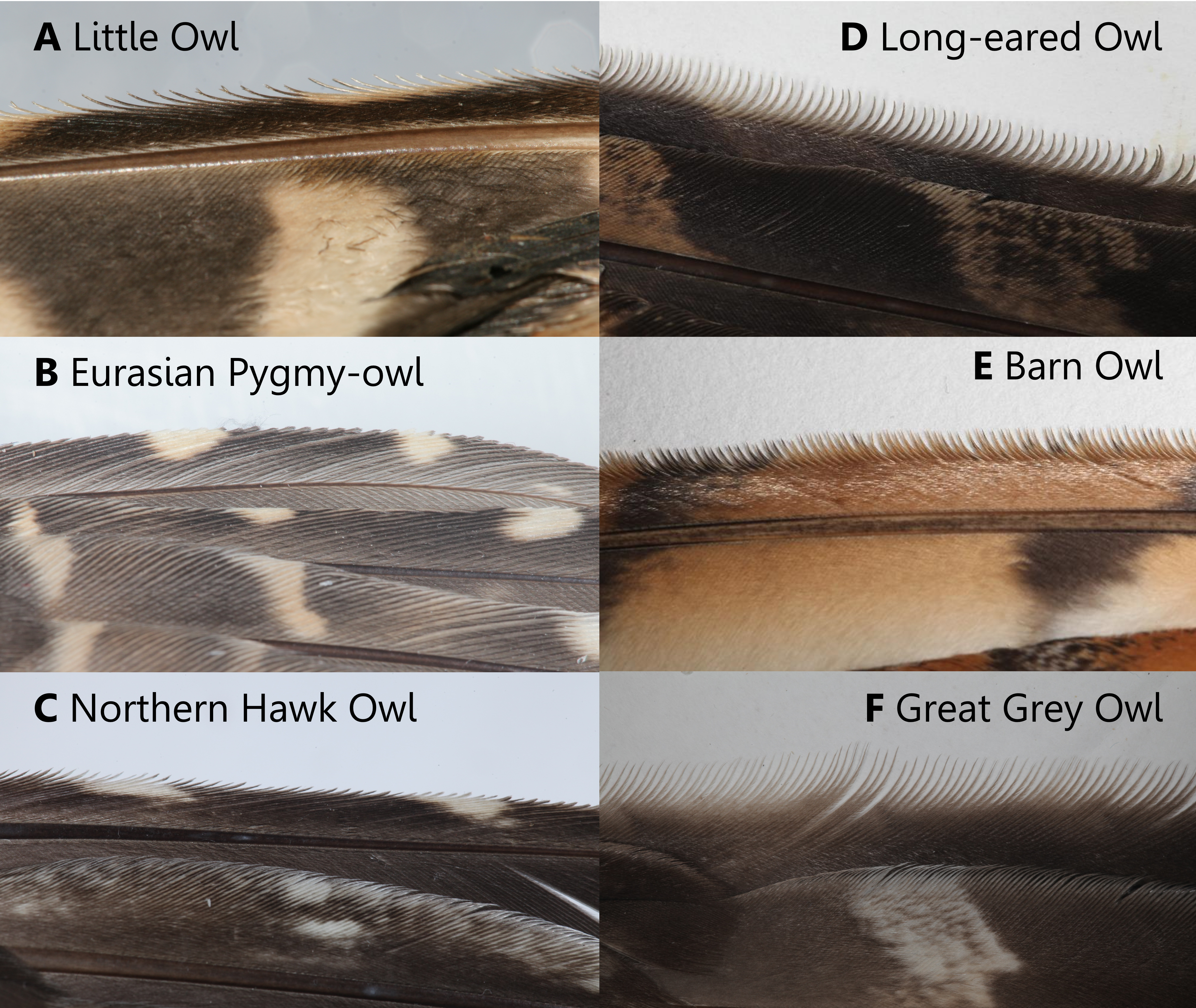
Another aspect enables most owls to have a silent flight: a low wing loading. This means that the body mass carried by the wing surface is relatively low, or in other words, the wing surface is relatively large for the body mass. A low wing loading allows a slower flight speed, which in turn produces less noise than a fast flight as a result of limited air drag and wing flapping. So, the relatively large wings of owls contribute to noise reduction by allowing slow flight!
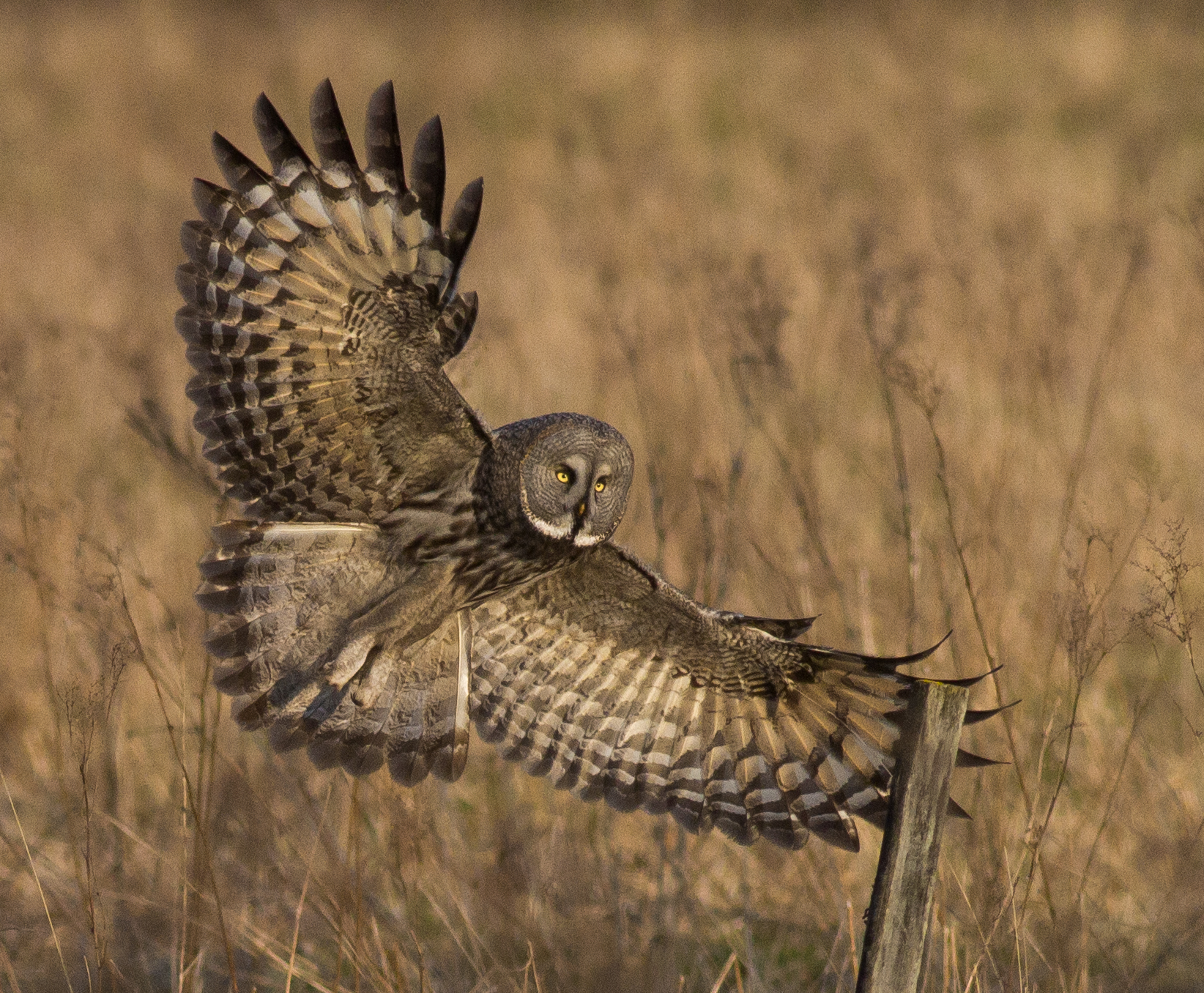
In relation to that you could wonder why most diurnal birds of prey also have large wings, as they do not have the need to fly silently. For many diurnal raptors the prey size is relatively large compared to prey that most owls catch, for which large wings can be beneficial in case of transporting a heavy catch, like the White-tailed Eagle here.

Secondly, many birds of prey spend long periods soaring in the air in search of prey, for which a low wing loading is very convenient as it minimizes the energy needed to fly. Another important factor for raptors that hunt by pursuing their prey, like some harriers (photo below) or Sparrowhawks, is that large wings provide a high manoeuvrability. A large wing surface allows them to change their course radically when the wings are twisted or turned. This means that a low wing loading can have several functions, depending on the type of hunting and lifestyle of the bird.

A low wing loading can also work for owls that hunt using high-speed flights, like Short-eared Owls, which need to manoeuvre fast in order to respond to prey cues in time in order to have success. The movements of the wings are powered by the flight muscles.
These muscles have to be large and strong enough to withstand the forces on the wing and body as a result of such acrobatic movements. The flight muscles attach to the breastbone, of which the keel (yellow plain) indicates the size of the cross-section – and therefore the potential power – of the muscle.
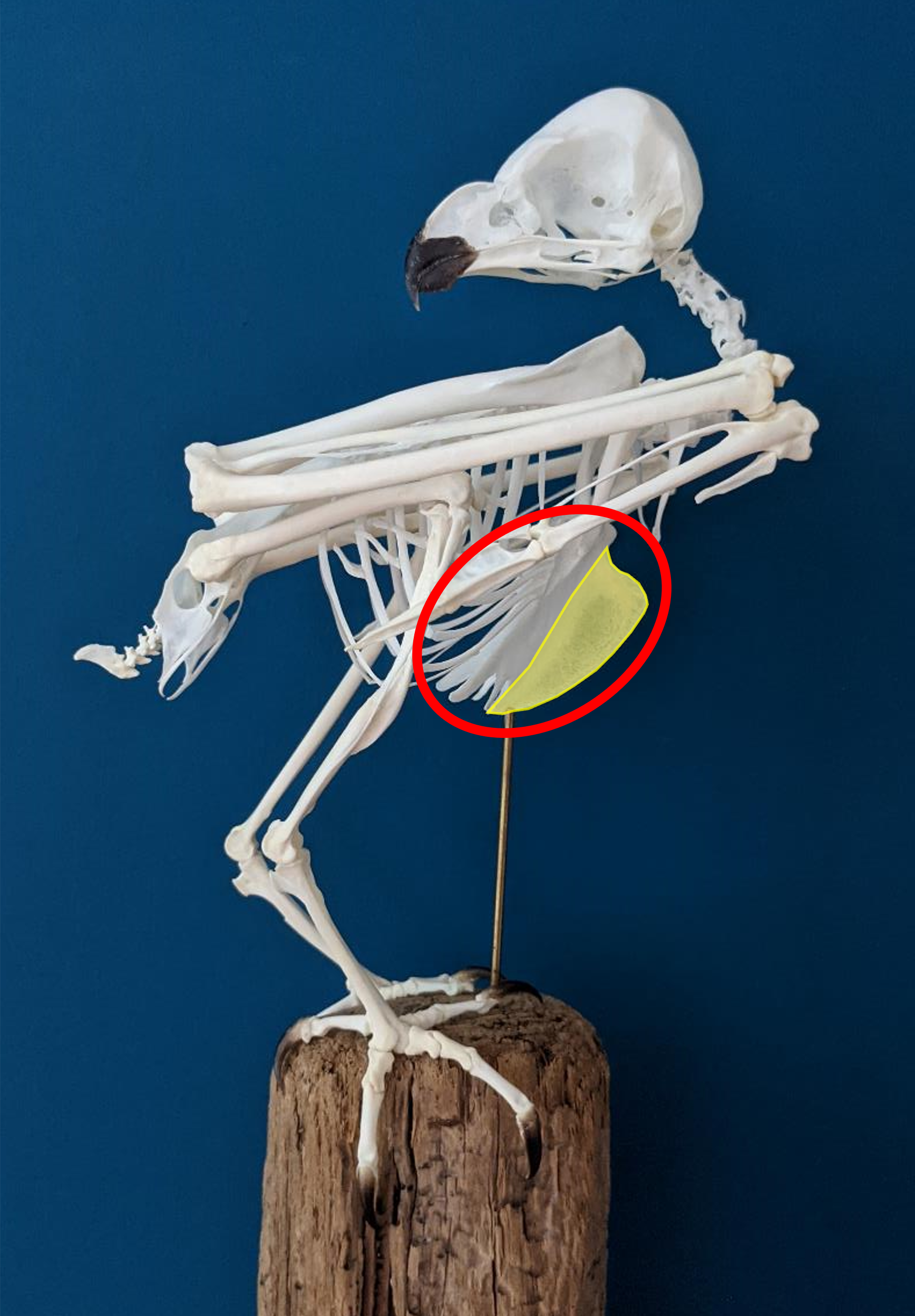
The advantage of comparing the size of the breastbone keel between species instead of the flight muscle itself is that muscle sizes vary with condition and breastbones do not. Compare the flight muscles of an owl in poor (left) and good (right) condition below.
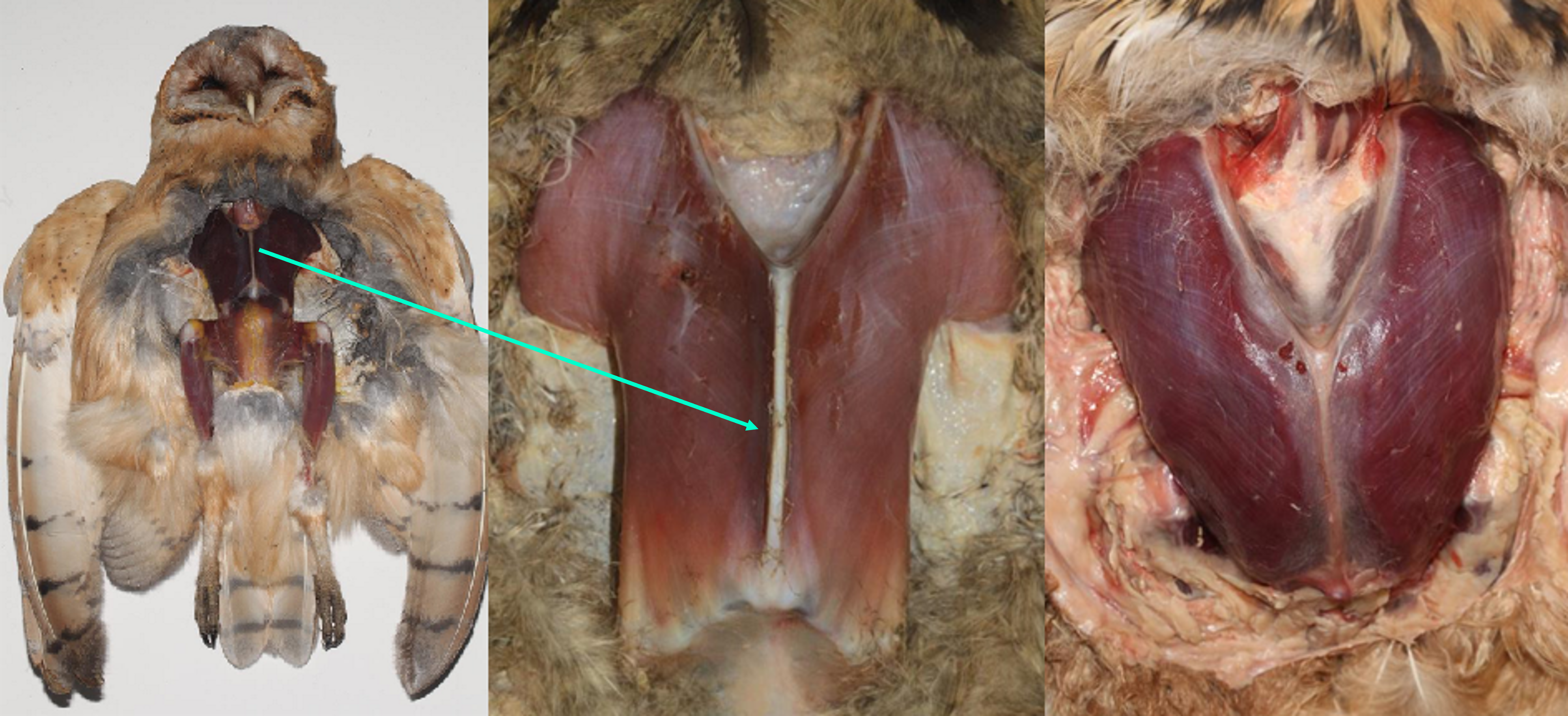
Even though wing loadings between owls and diurnal birds of prey seem quite similar, owls appear to have relatively small flight muscles – based on the keel size – compared to diurnal raptors (graph). This mainly has to do with the fact that many raptors have to actively chase their prey in pursuit, for which they need a powerful and fast flight, whereas most owls fly slowly in order to stay silent, using the element of surprise to catch prey. Vultures (encircled) are an interesting group of diurnal birds of prey in that sense. They are very large, but show relatively very small flight muscles; they search for food by soaring and lack the necessity to pursue prey, which requires relatively little muscle power.
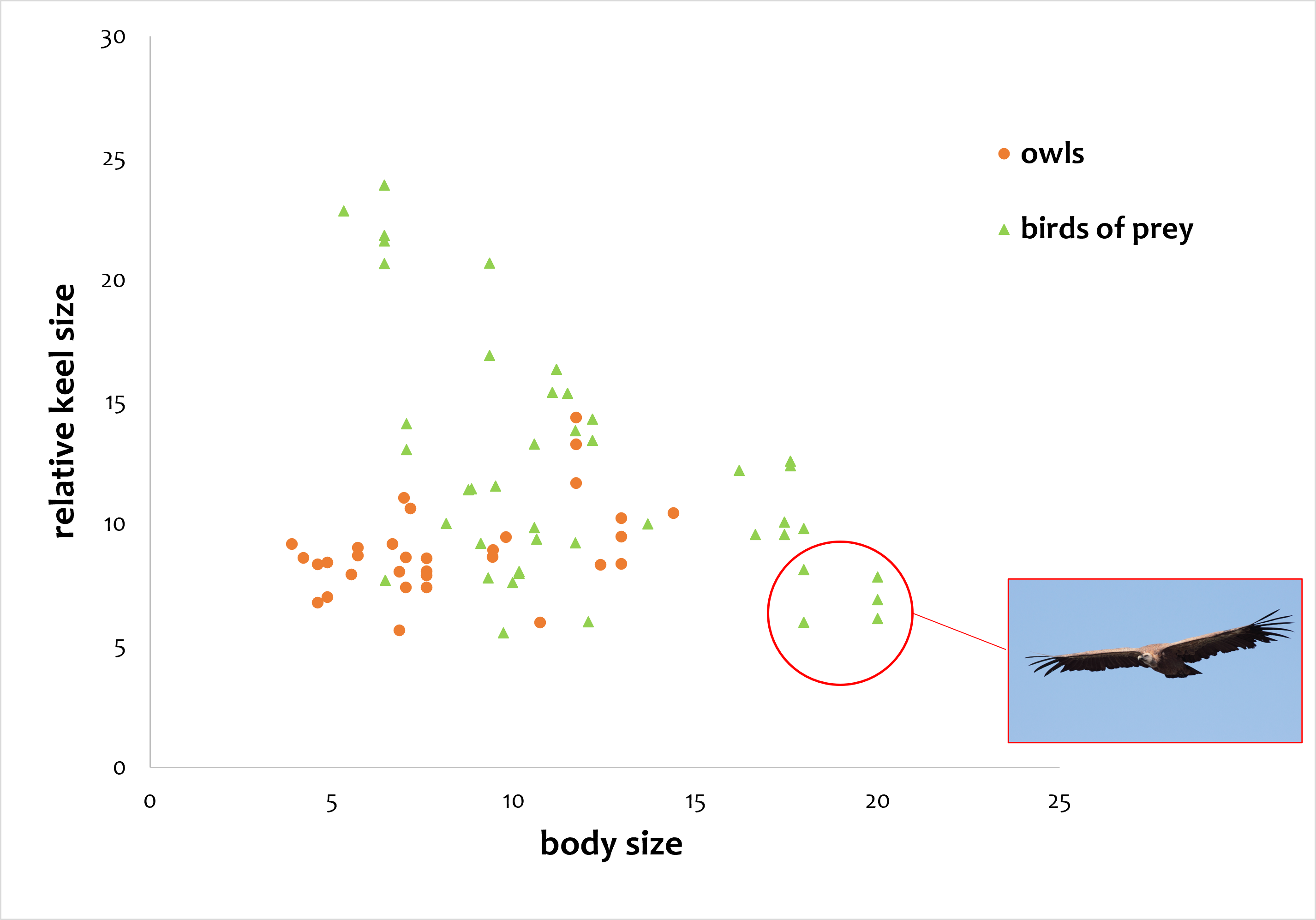
When zooming in on owls as a group, the flight muscle size appears to be highly variable. A logical expectation would be to find larger flight muscles as wing loading increases, because larger wings generally need larger muscles to control them. The graph below shows the relationship among owls between wing loading and flight muscle size (expressed in keel size), corrected for their body size. The line indicates the “average” relationship between the two characteristics for all European owls. Owls above the line have relatively large flight muscles for their size; owls below the line have relatively small flight muscles.

This graph shows that species that are very closely related and seemingly very similar, actually can be positioned on two extreme ends of the graph, like two species of the Asio genus: Long-eared Owl and Short-eared Owl. Short-eared Owls hunt open grasslands at high speeds with high manoeuvrability and also migrate over long distances, for which strong flight muscles are needed. On the contrary, Long-eared Owls are more of using a sit-and-wait and slow flight technique in denser habitats and have less need for migratory performances.
In fact, the variation between these related species is much larger than between unrelated species from other genera! The comparison between both Asio species shows that similarities develop as a result of ecological relevance, regardless of evolutionary (un)relatedness of species. This example shows very clearly that evolutionary relatedness is not per definition leading in morphology.


In addition to the surface area and flight muscles, the wing shape is a third factor influencing the flight performance of owls. The wing shape can be defined by the aspect ratio, which is a measure of how slim the wing is. The higher the aspect ratio, the slimmer the wing. Slimmer wings are more efficient as a result of reduced wind drag in flight, but require stronger (heavier) wing bones due to their length. So, why wouldn’t all owls have very long, slim wings?
Because long wings can be very inconvenient for certain habitats or flight types: imagine a forest-dwelling owl flying through a dense forest with very long wings.
Owl flight in a nutshell
Most owls, especially species hunting at night or in densely vegetated habitats, need to fly silently in order to minimize the noise hindering them from hearing prey. They can do so thanks to fluffy feathers and serrations and a low wing loading, which keep their drag and thus noise low. The wing shape is also an important factor determining flight performance. Alltogether, a large variety is present among owls regarding flight adaptations, most of which can be related to the different hunting techniques and lifestyles that different owls have. Diurnal raptors can share owl adaptations, but generally use them for different reasons that relate to their different lifestyles.
Now you have localised your prey, you know which angle of attack should be chosen and your silent flight can bring you up to the prey unnoticed. The last thing you need in order to actually acquire it are talons. Just like basically all raptors, owls catch their prey using their claws instead of their beak.
Are the claws of European owls as specialised and species-specific as their senses?

Prey capture
Legs
At first sight owls seem to have relatively short legs compared to most diurnal raptors. The main reason for this impression is the thick layer of feathers covering the body of owls, making their legs almost invisible on the outside. When looking under that cover of feathers, however, it turns out that the length of the legs is not that different between owls and raptors overall (graph). Although raptors are generally larger and heavier than owls, placing them higher in the graph, their relative leg length can be considered similar to that of owls: all dots roughly follow the same line in the graph. Here, we compare the lengths of the lower leg, made up of the shinbone and the tarsometatarsus, hereinafter referred to as shinbone and tarsus. No clusters can be distinguished for total lower leg length.
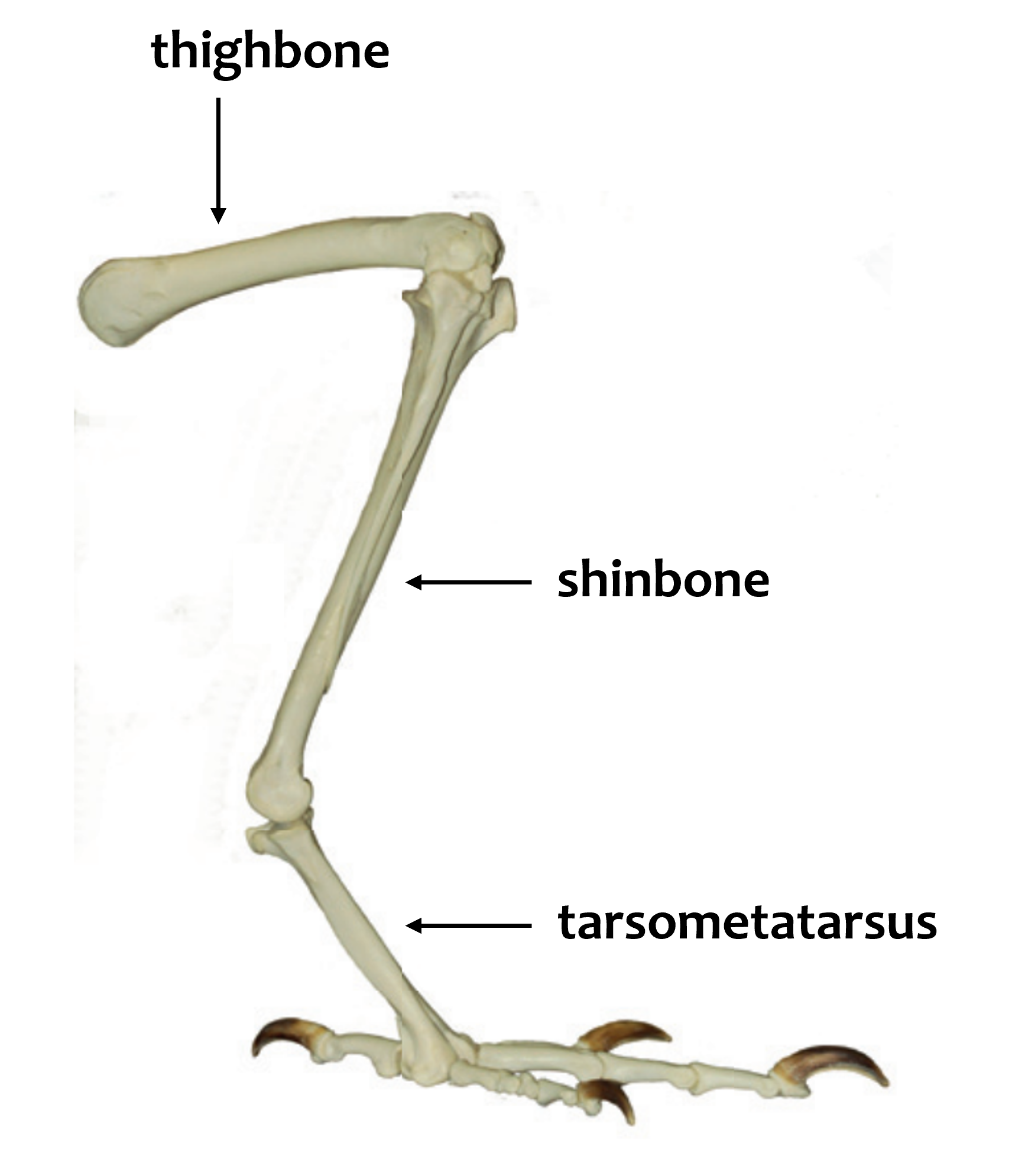

Remarkably, when comparing the shinbone and tarsus lengths with each other, two groups can be distinguished among both owls and raptors (blue lines in graph). This means that the shinbone length is variable, whereas the length of the tarsus bone remains quite consistent with body size. This leads to the question what the purposes of a longer shinbone might be.
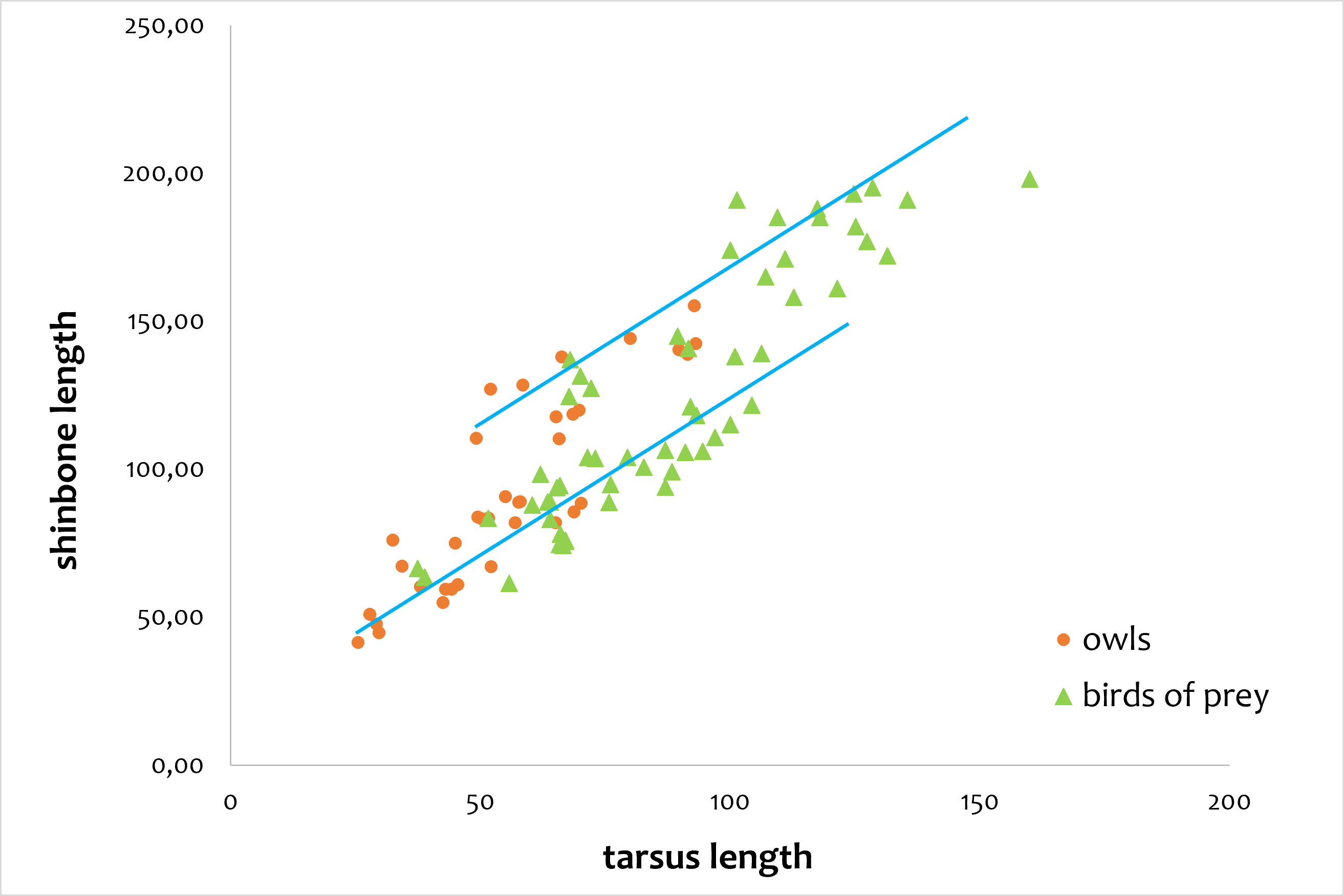
A longer shinbone results in a longer leg, which might be useful for owls hunting in tall vegetation, although having a longer tarsus might be more helpful. A more logical purpose of the shinbone is muscle attachment: the leg muscles operating the tarsus and the toes are positioned on the shinbone. This means that a longer shinbone might offer more space for leg muscles to attach to and therefore result in a more powerful grasp.
The graph below shows that for example Snowy Owls, Ural Owls and Eurasian Eagle Owls have relatively long shinbones. How does that relate to the lifestyles of these owls? It could be related to the large prey they are known to hunt and the grasp needed to kill and transport the catch.
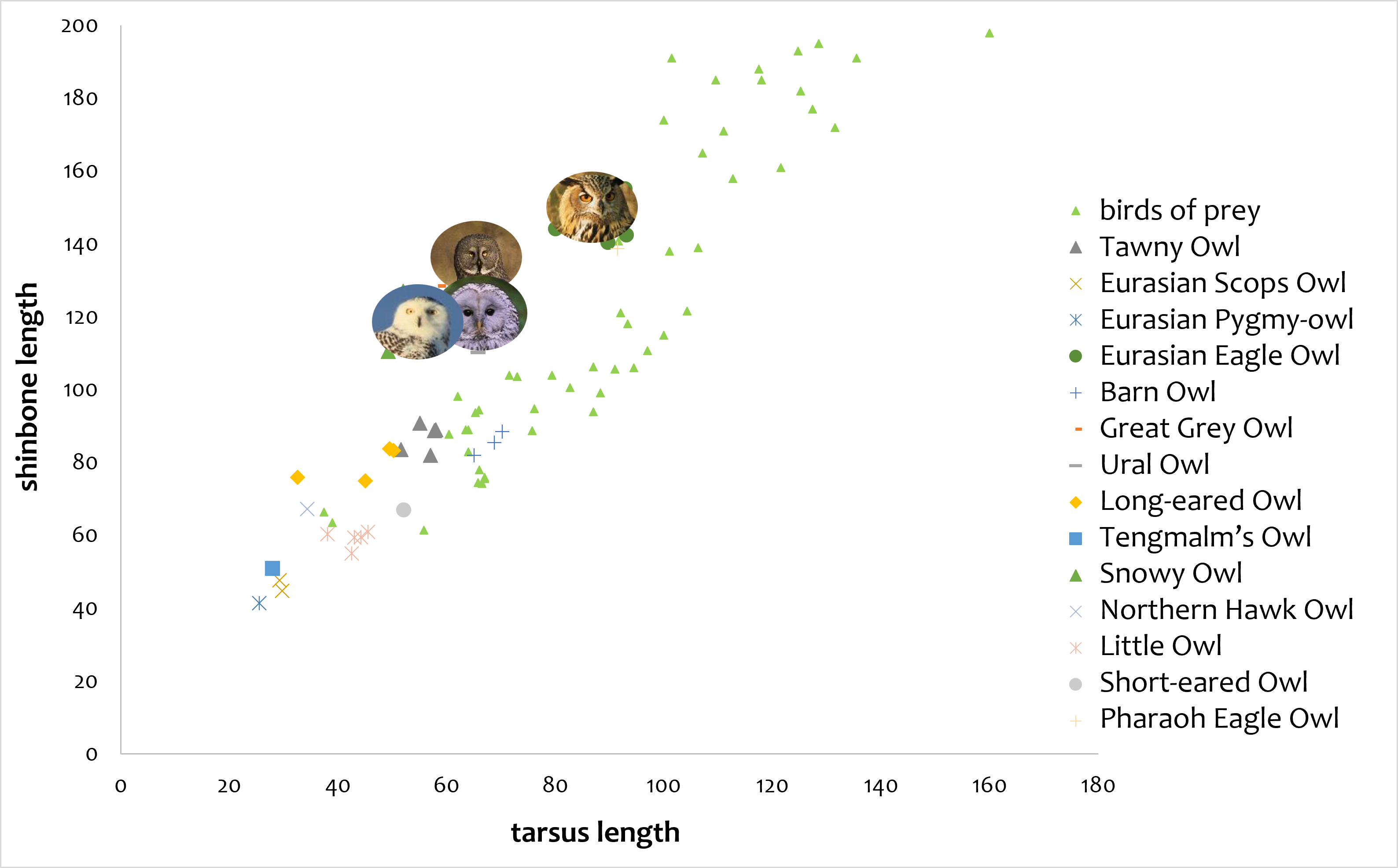
Another owl species with a long shinbone is the Great Grey Owl, which is built less powerful than the species mentioned before. For them, the heavy leg muscles might serve another purpose: in winter Great Grey Owls are known to hunt small mammals under thick snow cover, which might require relatively strong leg muscles in order to reach through the snow layer. Having long legs is also beneficial in this sense, simply because it gives them a larger reach for prey, similar to species hunting prey in tall vegetation. Based on this assumption, it seems that owls and raptors grabbing large prey or into deep snow cover have larger leg bones (and muscles) than species that do not.
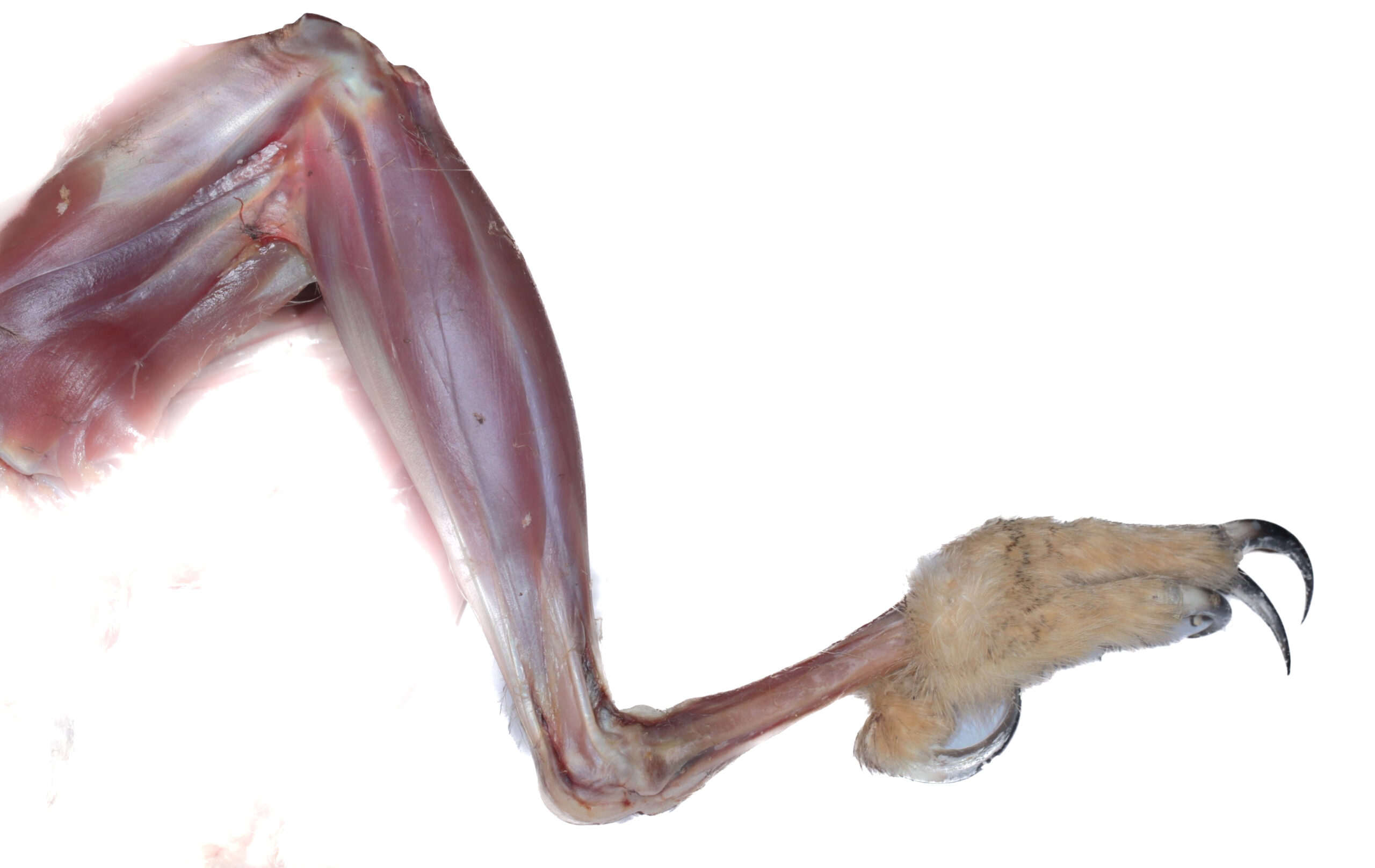
Turning toe
A well-known feature of owls is the ability to twist their lateral toes backwards, often referred to as their so-called turning toe. When at rest, the lateral toe is positioned forwards together with the central and inner toe (A). When twisted backwards, two toes point forwards and two backwards, creating a cross-shaped foot arrangement called zygodactyl feet (B). The idea behind this feature is that owls can enclose smaller prey better with talons arranged this way.
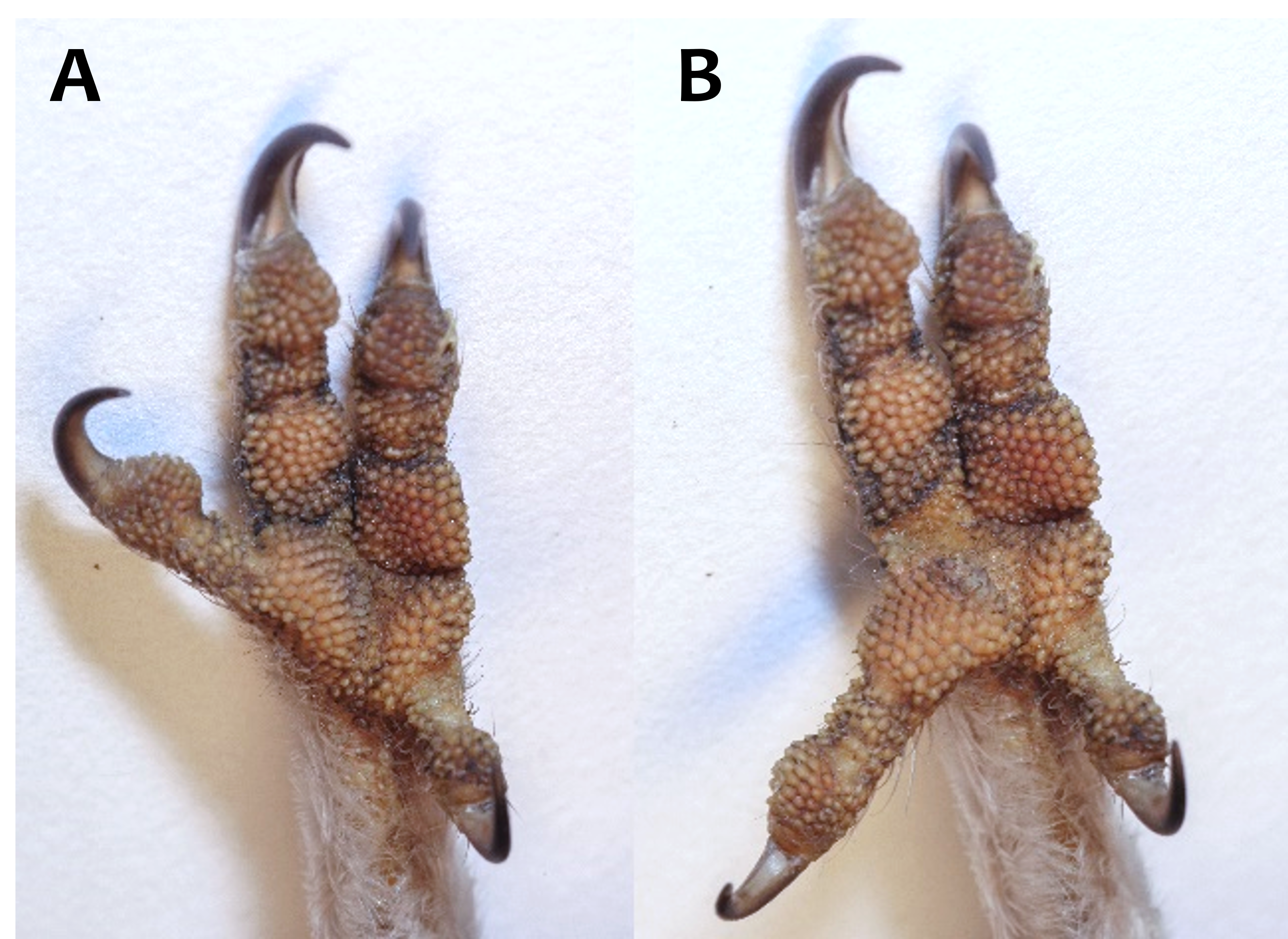
When zooming in upon the variation of the ability to twist the toe backwards among owls, it becomes clear that differences can be significant, both between and within genera. Tawny Owls and Ural Owls, for instance, can turn their toes backwards up to an extreme angle, whereas Eurasian Eagle Owls are much more restricted in turning their toe back, and even resemble diurnal raptors in this sense (graph). Owls that generally catch small prey, like Little Owl and Eurasian Scops Owl, also seem to benefit from this adaptation. Therefore, the size of prey – or the need to hunt opportunistic – is most likely the explanation for the functionality of having a well-developed turning toe.
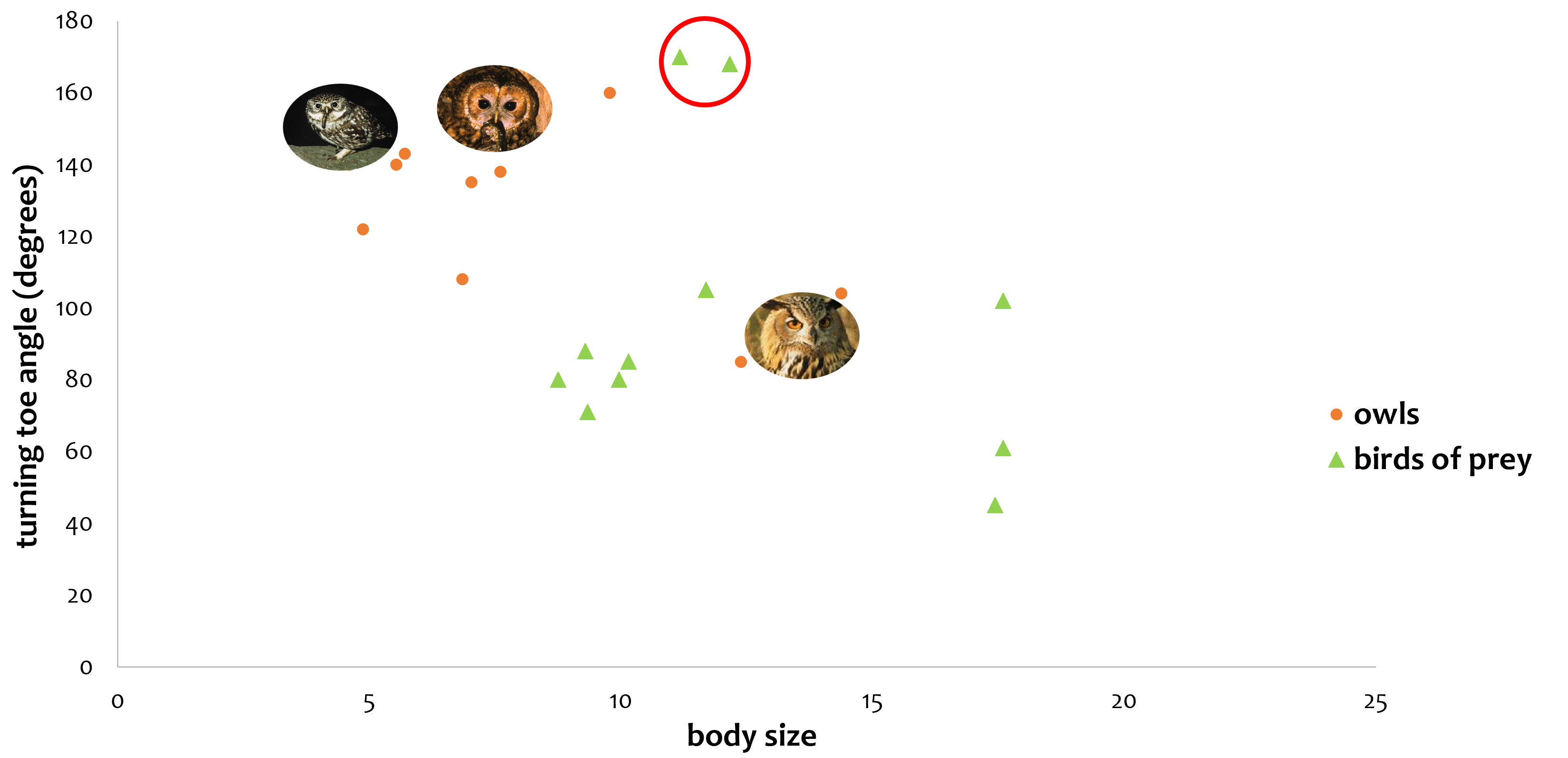
For species that exclusively hunt small prey, like voles, it can be very beneficial to have talons fully enclosing a victim. For species hunting a large variety of prey types including large prey, like eagle owls, it might be less beneficial. This also means that having an effective turning toe is not strictly related to an owl’s size. The graph also shows two remarkable data points of birds of prey with a very large turning toe angle (encircled red). Which raptors could this be?
BOX IV – Fishing toes
Although turning toes are generally thought to be restrictedly found in owls, there seem to be exceptions. Strikingly, there is a bird of prey sharing this adaptation with owls: Osprey! These fishing raptors possess an extreme ability to turn back their lateral toe as well, even further than most owls, which they use to grab and transport a fish in such way that it can be carried head-first through the air, significantly reducing the drag in flight.
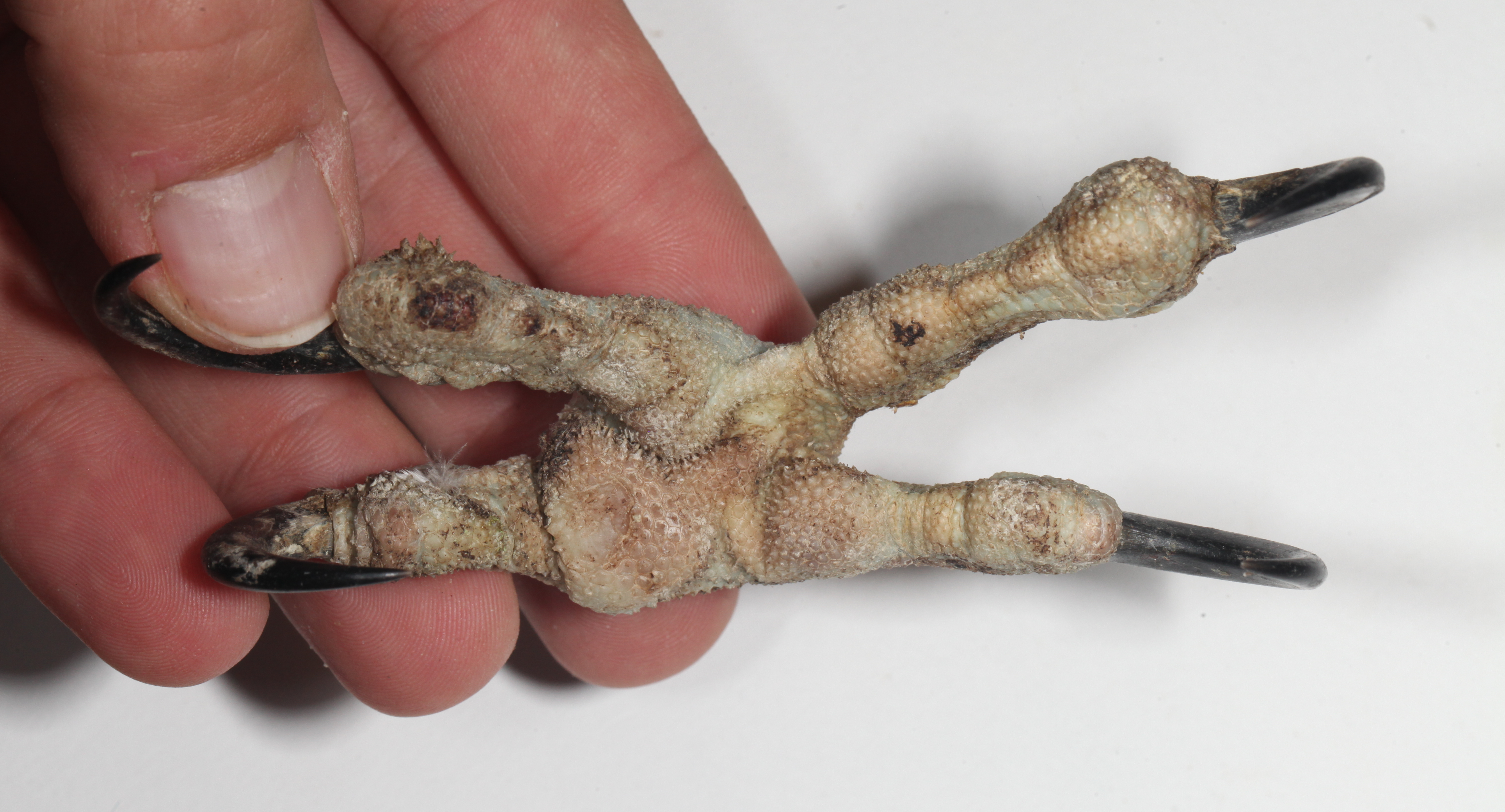

Prey capture in a nutshell
The length of the shinbone is quite variable among owls, in which long bones can provide more space to attach leg muscles on to. More muscles represent a higher muscle force an owl can deliver when grasping prey or when reaching through snow layers, resulting in long leg bones to be found in owls in need of relatively much muscle power. The typical turning toe is found to be well-developed in owl species hunting small prey. It can even be found in a diurnal raptor species: Osprey use a highly developed turning toe in order to grasp fish in flight!
Owl talons are not as specialised as their senses, but do show quite some variation related to different diets and lifestyles of owls. Anyway, all the hard work is done now. The prey is caught and can be ingested as a reward for a successful hunt. How do owls process their prey and how is that different from raptors?

Prey processing
Mouth
As a first step the prey must be swallowed in order to start the digestion process. Owls have a relatively wide mouth relative to their size compared to raptors (graph), which allows them to swallow their prey whole. One might think that this is an adaptation that specially evolved to process large prey, but that is not the case. To explain how this feature actually developed we compare owls to nightjars, which are nocturnal aerial hunters that also have wide mouths for their size (blue dots), which they use to collect insects in flight.
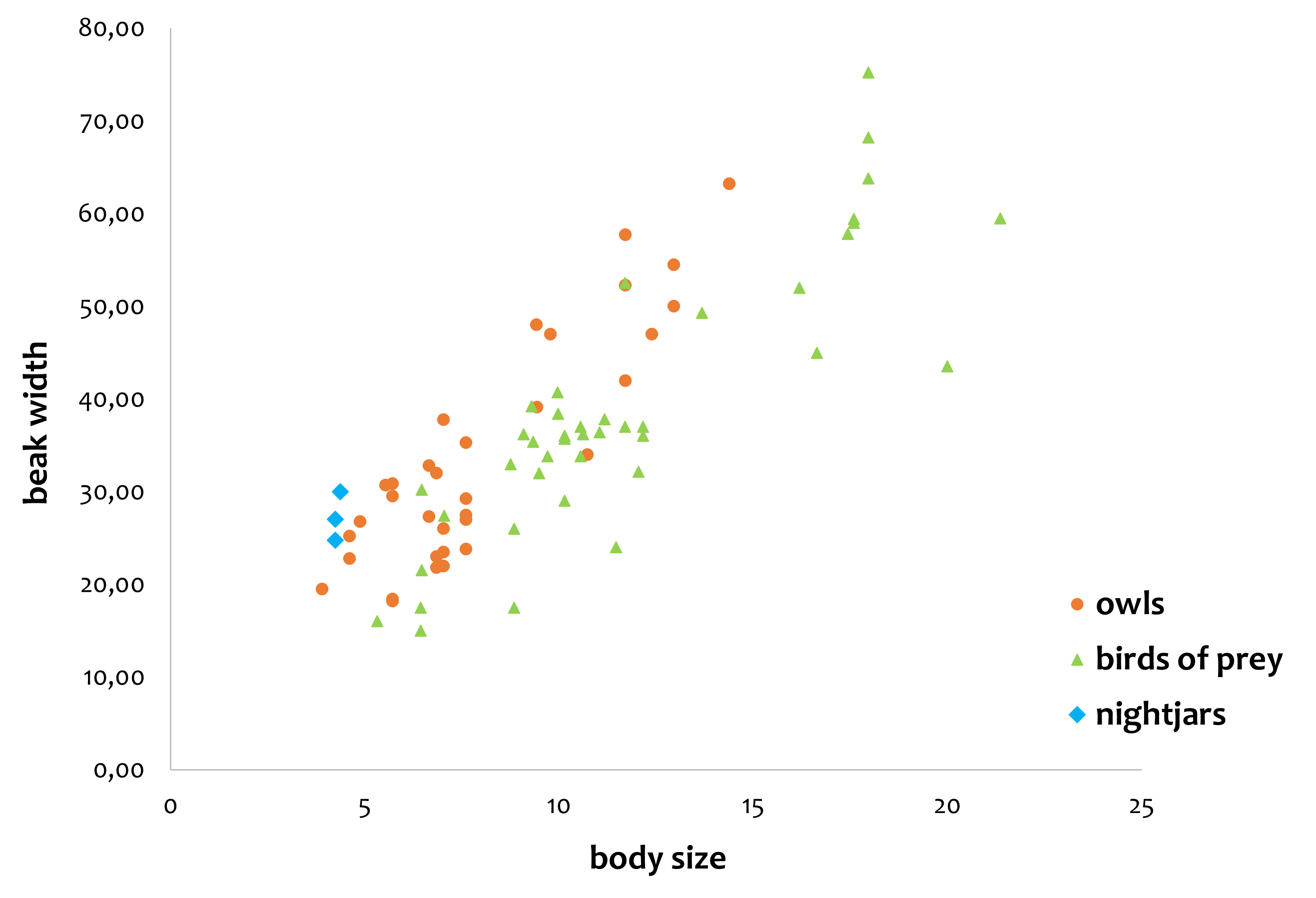
Taking a look underneath the skin of these birds we can quite easily tell what causes them to have a wide mouth: owls have broad heads and mouths accordingly as a result of their very big eyes, forcing the skull to expand to the sides (drawing A).
In nightjars, however, the size of the beak determines the width of the skull (drawing B). In both skulls the brain did not expand with the size of the skull and additional spaces resulting from this shape are filled up by spongy bone tissue. So, in nightjars the size of the mouth and in owls the size of the eyes seems to have determined the size of their head.

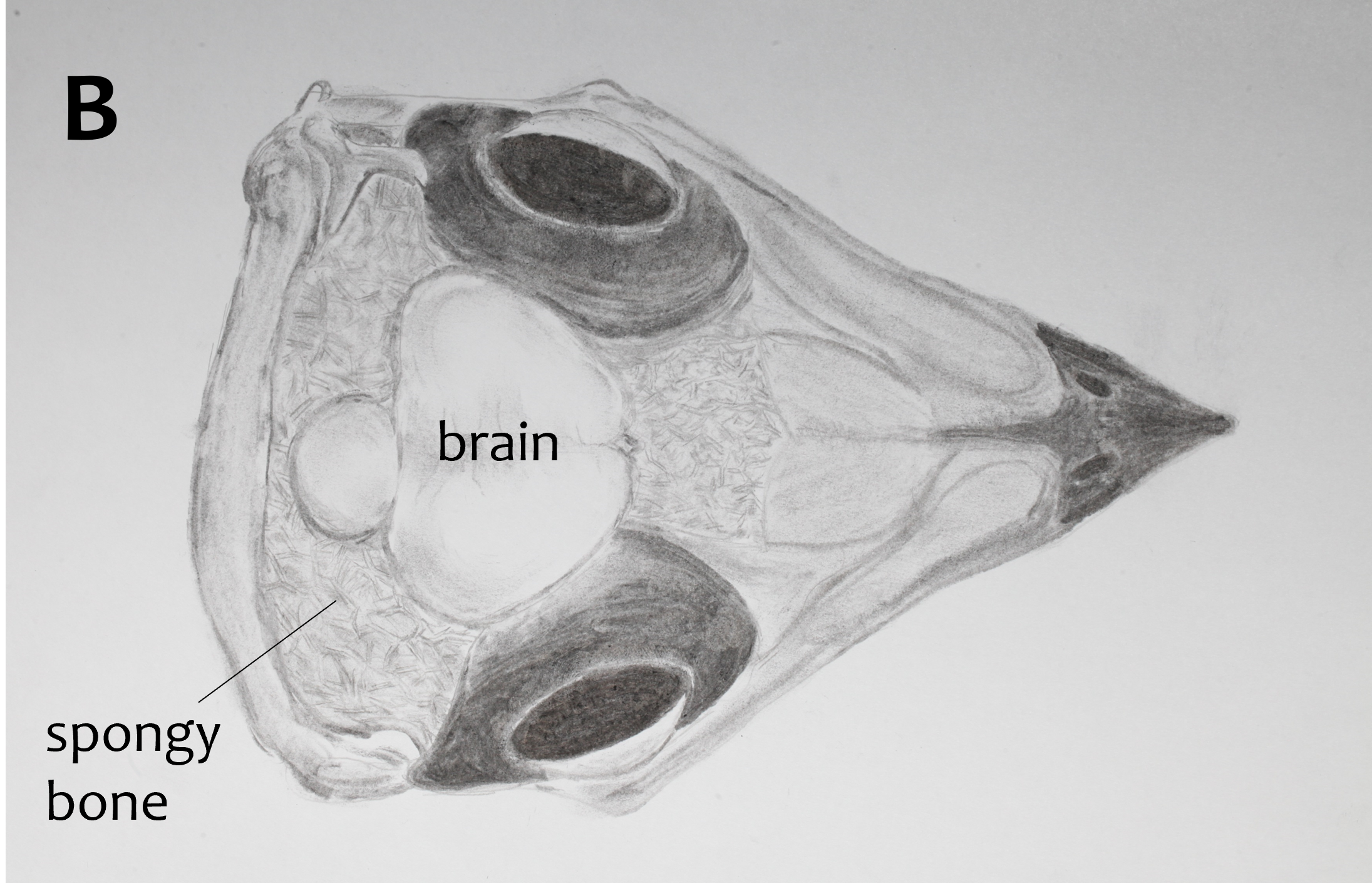
For many owls, having a wide skull – and therefore a wide beak – resulted in the luxury to swallow prey whole. Consequently, swallowing big prey whole might have resulted in the lack of a crop in owls, as prey of that size may be too big to store in it. Raptors do have a crop, in which they store ripped-off pieces of their prey, ingesting it bit by bit. Larger owls or owl species catching relatively large prey also first dismantle their catch before ingesting it, similar to birds of prey.

Digestive system
After swallowing (and lacking a crop), food items run through the oesophagus and enter the stomach, of which the size also seems to relate to the prey (partical) size that owls eat. Larger species like Eurasian Eagle Owls, which dismantle their prey and swallow it in pieces, show stomach sizes comparable with those of diurnal birds of prey. Medium and smaller owls like Barn Owl or Little Owl, however, have relatively large stomachs compared to diurnal raptors of similar size, which allow them to store a fair number of larger prey. These can be rodents, birds, insects or even worms and spiders, depending on the species (here a Tawny Owl stomach filled with earth worms).
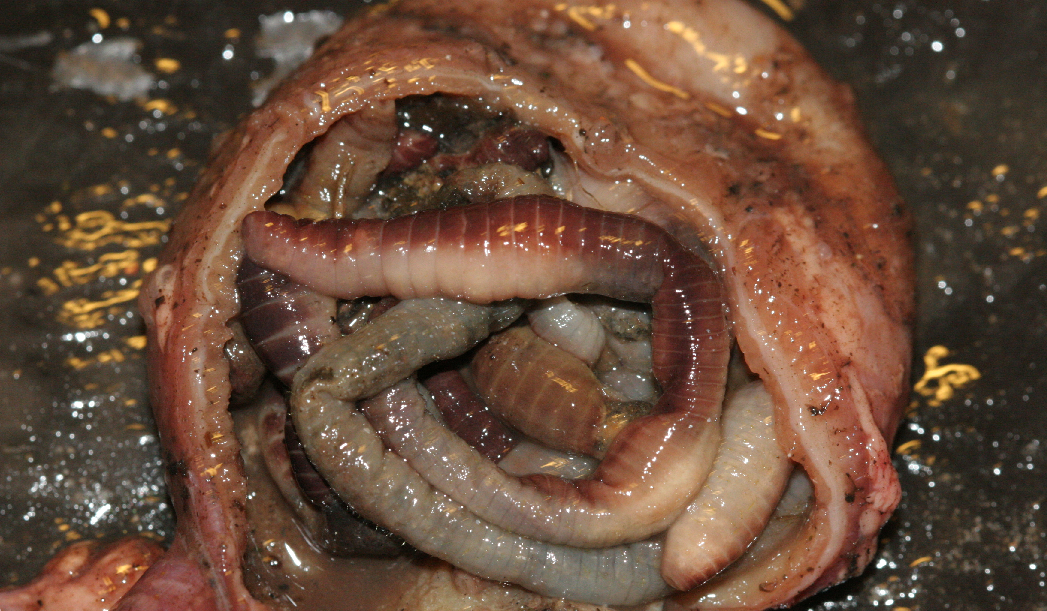
To get an idea: we found stomachs of a single owl holding up to six or seven mice and large numbers of various other prey! It is quite small when empty, but it can expand quite a lot when holding prey. Here, the relatively small-looking stomach of a Barn Owl held two mice and a shrew.
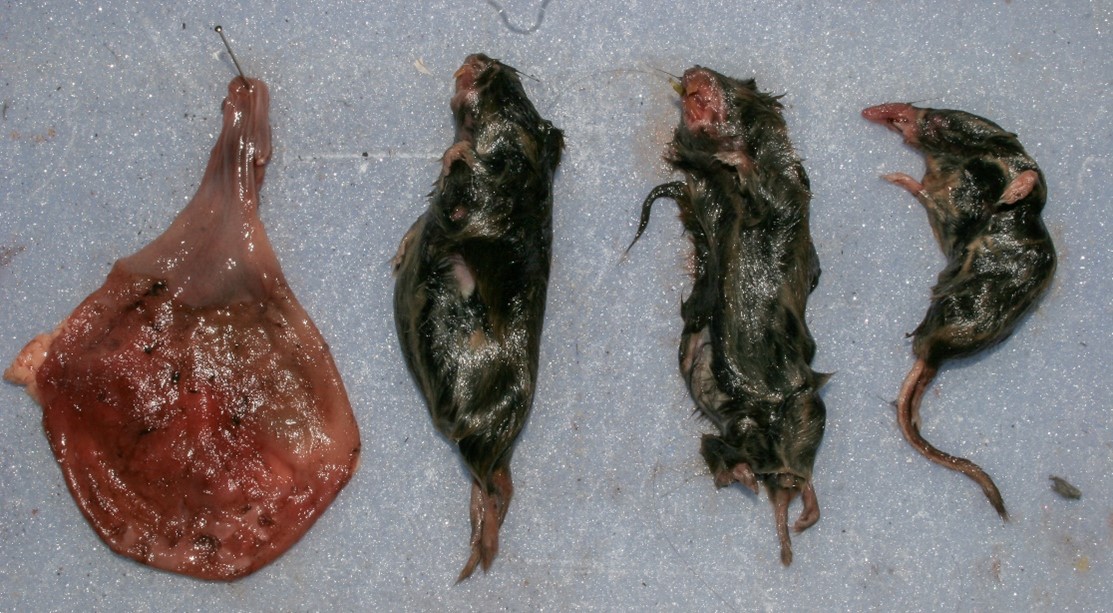
The actual digestion starts in the stomach, where acidic fluids and digestive enzymes are added to the content. Then it passes through to the intestine, which is relatively short in owls, just like in most other carnivorous birds. The variation in intestine length among owls appears to be very small. Owls, however, do have an adaptation in their digestive system unlike diurnal raptors: caeca (blue arrows).
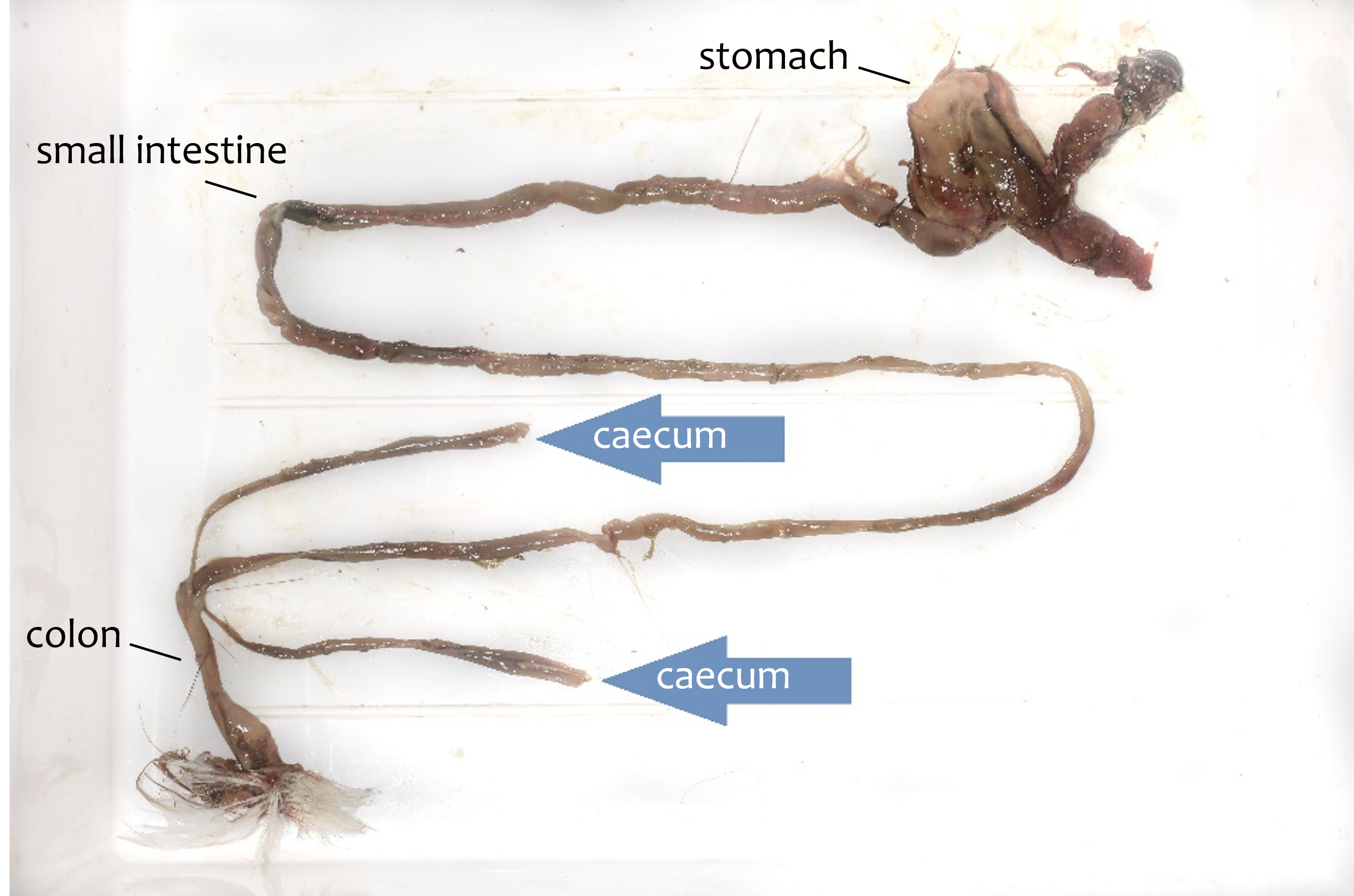
Caeca are blind guts, dead-end tubes in which bacteria process waste products, connecting at the end of the small intestine. These waste products are uric acids from the kidneys, which are transported from the cloaca back into the caeca using anti-peristaltic movements. The bacteria present in the blind guts produce proteins from these uric acids. In turn, the owl can digest the proteins produced by the bacteria, which can make a significant contribution to an owl’s basic energy needs. The ability of owls to use their blind guts as an extra energy source where birds of prey cannot, could make a difference in times of food shortage or affected habitat quality.
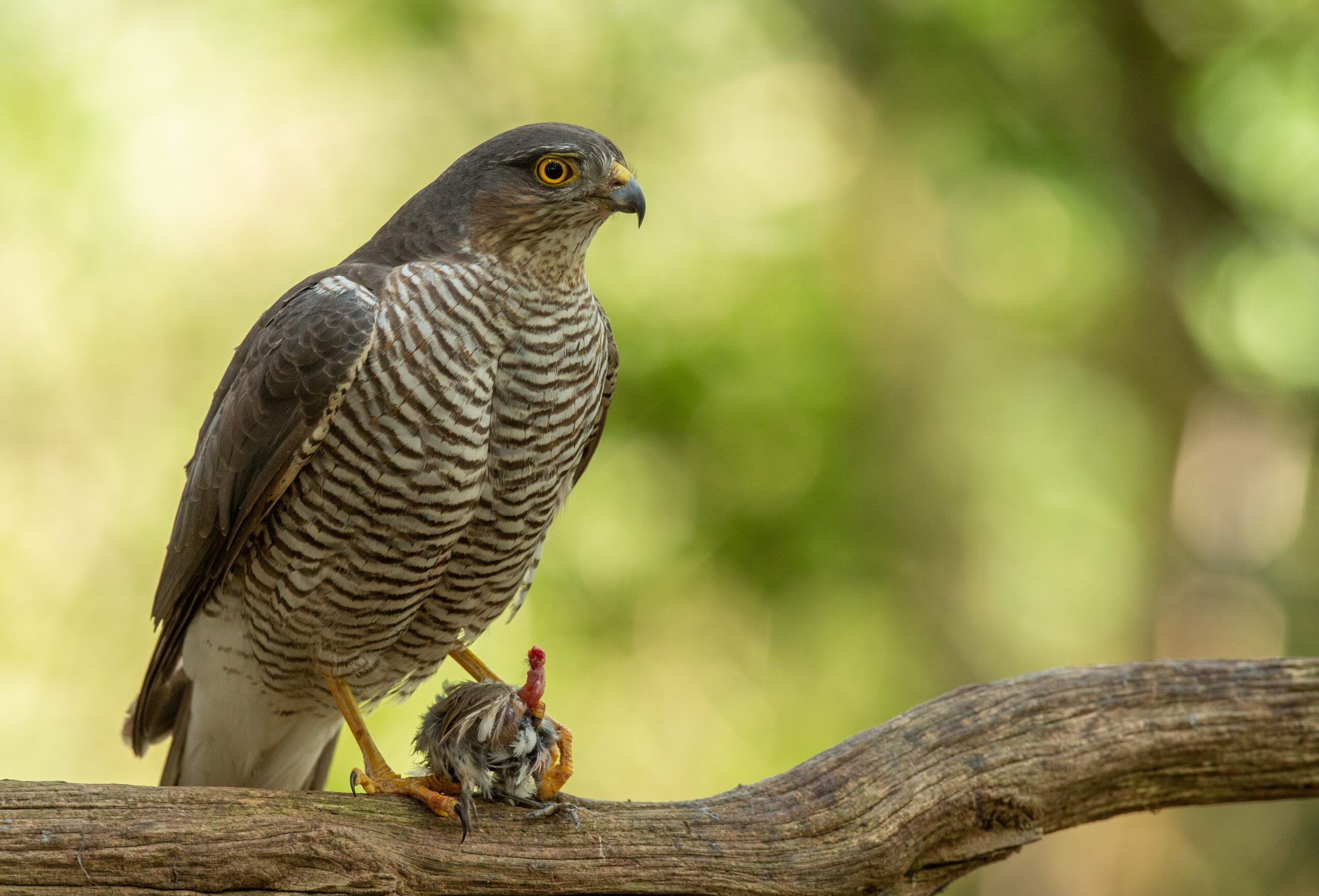
Sparrowhawks, for example, share habitat with Tawny Owls in Western Europe and show a negative trend over the past few decades, whereas Tawny Owls do not. Having blind guts could just be enough for the owls to overcome the difficulties that hamper breeding success in Sparrowhawks.

The body condition, time of year and sex may all influence the size of blind guts in owls. This results in a large variation of blind gut size within species, which makes it difficult to compare the actual differences in functionality between species. Despite this variation, owls living in tight balance with prey intake or with additional amino acid needs (e.g. for egg production) are expected to have larger blind guts.
Prey processing in a nutshell
The large, forward facing eyes of owls seem to have resulted in a wide skull and, consequently, a wide beak. This allows them to swallow prey whole unlike raptors and may even be the reason for owls to lack a crop. Stomachs of owls are generally large, especially in smaller species, and serve to store large food items whole. The rest of the digestive system shows little variation among owls, although all owls have a unique feature: blind guts. In these guts bacteria process waste products from the kidneys, which can make a significant contribution to an owl’s basic energy needs. The ability of owls to do so could even make a difference in situations of food shortage or affected habitat quality.
The circle is complete! You’ve succesfully detected, located, caught and processed your prey using unique and highly-advanced adaptations. The differences with diurnal raptors have been proven to be quite big in many aspects, although they are quite closely related to owls in evolutionary sense. And as you have learned on the way, the variation among owls is noteworthy: many types of owls have their own secrets, enabling them to function and survive in a certain habitat.
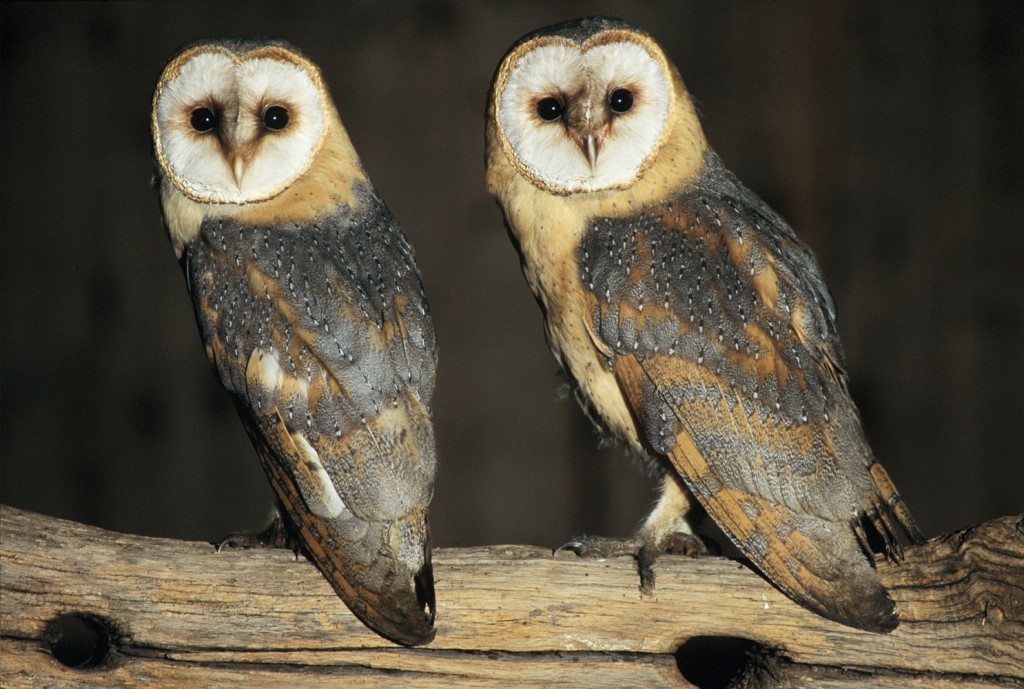
Summary
Main findings
This summary gives an overview of the main findings we can derive from this European Owl Special, based on the combinations of owl anatomies and lifestyles:
- Hearing adaptations are a dominant factor in (the origin of) owl morphology, although some owls nowadays show little advanced hearing adaptations
- Owls and birds of prey differ more than would be expected at first sight
- Nevertheless, dependent on size and ecology, some adaptations show some overlap between owls and birds of prey
- Owl species clearly differ, even if closely related, in relationship with ecological differences
- Within a species, characteristics can vary a lot due to individual differences
Owl types
Based on the findings of this special we can make a new classification of European owls, based on their morphology rather than on taxonomical position. Such a classification – based on morphological traits and ecological niches – can be considered an overview of the different types of owls in Europe. As concluded above, the extent to which owl hearing adaptations are developed is a dominant factor in the morphological classification, which distinguishes three groups among European owls: 1) owls with excellent hearing, 2) owls with intermediate hearing and 3) owls with poor hearing.
Eye size is another important factor determining which environment an owl can live and navigate in, because orientation in an owl’s habitat is not possible upon hearing only. For prey detection some owls use their hearing primarily, whereas others mainly rely upon eyesight or use a combination of both senses. The following distinction with respect to eye size can be made: 1) owls with small eyes and 2) owls with large eyes.
A third distinction can be made upon adaptations for flight performance in the sense of wing shape (in relation with habitat) and the breastbone keel size (representing muscle power): 1) owls with long, slender wings and 2) owls with short, broad wings and 1) owls with large breastbone keels and 2) owls with small breastbone keels, respectively.
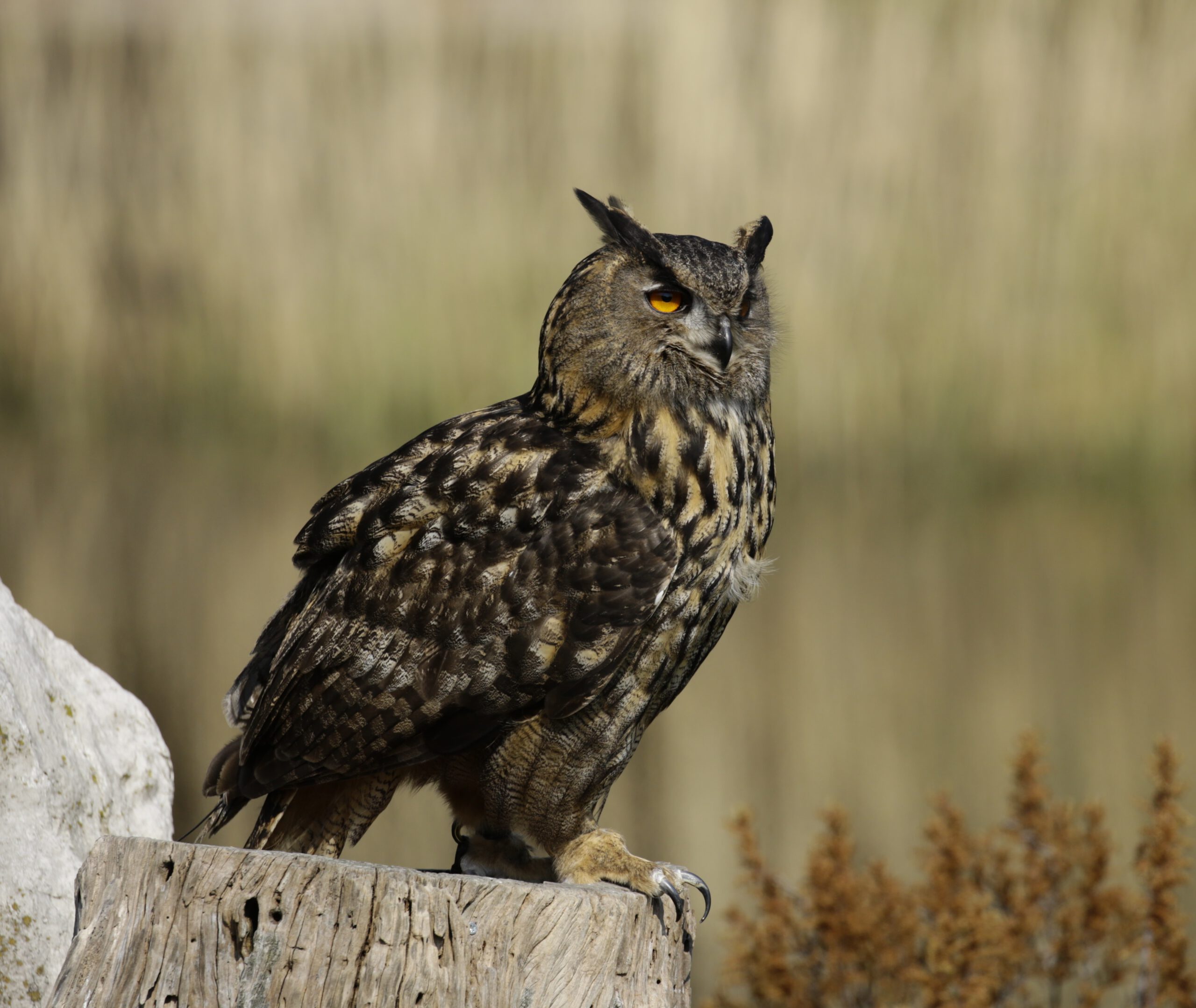
The combinations of the traits mentioned above summarize how each owl type can detect its prey and which flight performance is needed in order to find the prey, including potential migration. Additional aspects (e.g. shinbone length, habitat and body size) further differentiate niches within the categories made above. A morphological classification as described above results in 9 owl types and 14 different niches – equal to the number of species – meaning that each species seems to fullfill a unique niche!
The figure below shows the morphological distinctions made and the ecological niches resulting from it: each number (1-9) represents such an ecological niche. Interpretation of each niche and additional distinctions within niches are clarified below the figure (legend).

Legend
1. Nocturnal prime eyesight hunters: a slight niche difference among this type is represented by species with flight adaptations supporting migration (Eurasian Scops Owl) against sedentary species with poor flight adaptations (Little Owl).
2. Migratory diurnal prime eyesight hunters: Snowy Owls are adapted to diurnal hunting and migrate to follow prey fluctuations. They can even be restricted to hunting in complete daylight conditions during midnight sun periods in polar areas.
3. Sedentary diurnal prime eyesight hunters: this type of diurnal eyesight hunters lack the flight adaptations that allow migration (Eurasian Pygmy-owl)
4. Nocturnal hunters using eyesight & hearing: the distinction among this type of owls is primarily body size, which probably also relates to prey size and type that a certain habitat offers. Large species generally require a habitat with larger/more prey, although large species (Tawny Owl) can also exclude smaller species by predating upon the latter (Tengmalm’s Owl).
5. Nocturnal hearing hunters of open landscapes: these owls show a high overlap in habitat type, but are probably distinguished based on nesting ecology, in which some are cavity nesters (Barn Owl), whereas others depend on trees or abandoned nests of other birds (Long-eared Owl).
6. Diurnal hearing hunters of open landscapes: this type uses its excellent hearing to hunt prey in densely vegetated areas, because hunting upon eyesight nearly impossible. The ability to migrate can be crucial for this type in order to follow prey fluctuations.
7. Hearing hunters of half-open & forested landscapes: among this type, some owls hunt upon hearing in forested areas (Ural Owl), whereas others roam half-open or taiga habitat (Great Grey Owl), sometimes even using their excellent hearing to catch prey invisible to the eye by snow cover, for which they seem to benefit from long shinbones that provide power and range to reach through the snow.
8. Eyesight hunters with little hearing adaptations and large eyes: these owls seem to have highly adapted eyes for hunting, and despite being diurnal for a large bit, they also have some hearing adaptations (Northern Hawk Owl).
9. Eyesight hunters with little hearing adaptations and small eyes: this type seems to have the least advanced senses (small eyes & restricted hearing adaptations), but their large size might allow them to catch larger and easier-to-detect prey. Further distinction can be made based on flight performance, related to being highly opportunistic in a challenging habitat (Pharaoh Eagle Owl) or having higher prey densities to the exposal (Eurasian Eagle Owl).
Beyond Europe
Apparently, a large number of owl types is present among European owls, in which all species even seem to fullfill a unique ecological niche. However, a diurnal eyesight hunter of forested areas does not seem to be present among European species. How would this be in other parts of the world? Do owl species fulfill the same niches in other habitats, and do they overlap among species?
In order to answer part of that question, we will be studying the North-American owls soon in order to find out if new niches or owl types can be distinguished!


